
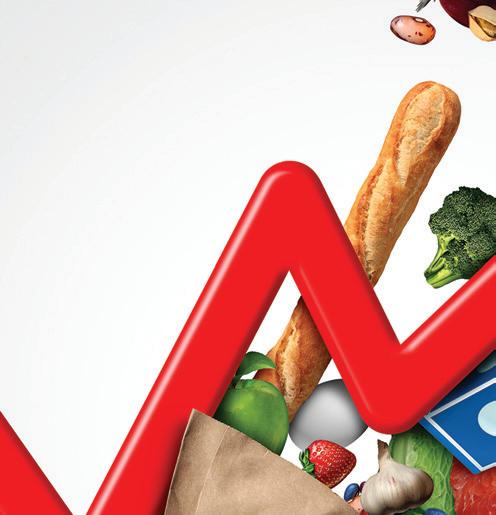


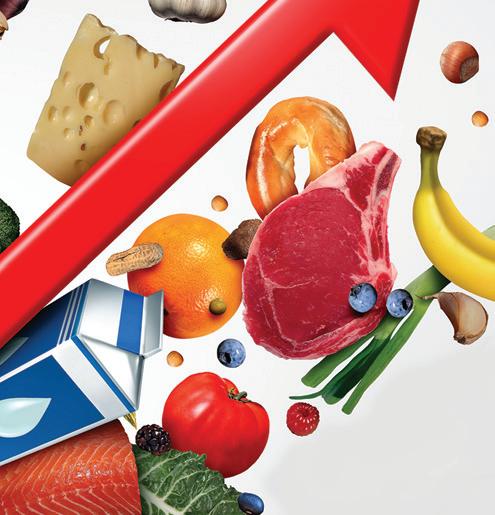



Holiday Entertaining Guide: Spring & Summer Edition BIG ON BACON Promote this favorite food across dayparts OPTIMAL FOOD SAFETY Win with tech-enabled, standards-based solutions MAKE SUSTAINABILITY PAY Find out the best ways to boost ROI through ESG March 2024 Volume 103, Number 3 www.progressivegrocer.com Shop Shifters How inflation is transforming shopper behavior 75 TH CONSUMER EXPENDITURES STUDY

PG’s 75 th Consumer Expenditures
goes directly to shoppers to explore not only what they’re buying in supermarkets, but also why they’re making certain decisions.
19
Sea of Convenience
Frozen and shelf-stable options should be promoted as great choices for inflation-weary and cooking-averse consumers.
22
Party Central
Grocers and brands offer a host of solutions for celebrations that draw shoppers
28
Bacon for All Occasions
Food retailers and brands find even more uses for this perennially favorite food.
34
How grocers can take advantage of the fast-growing retail foodservice segment.

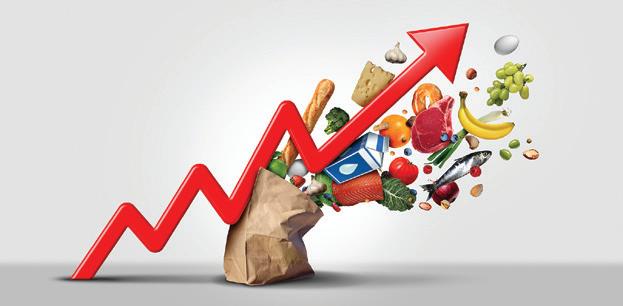
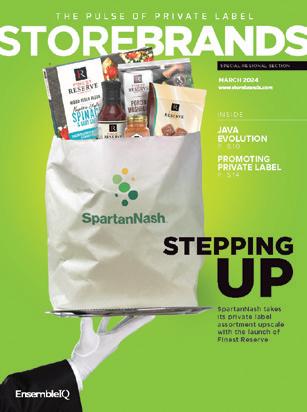
38 GUEST VIEWPOINTS
Verifying Receipt for Food Traceability
Tech-enabled, standards-based solutions improve accuracy, enhance efficiency and ensure compliance.
42 FEATURE
Going Behind the ROI of Sustainability
Grocers know sustainability initiatives are crucial to their businesses, but how can they prove the return on investment of such programs?
53 EQUIPMENT & DESIGN
Focus on Fixtures
Find out how flexibility and mobility can change the game.



Features Contents 03.24 Volume 103 Issue 3 10 NIELSEN’S SHELF STOPPERS Salty Snacks 11 MINTEL GLOBAL NEW PRODUCTS Dairy and Nondairy Milk Departments 12 ALL’S WELLNESS Getting the Most Out of Health-and-Wellness Tech 58 AHEAD OF WHAT’S NEXT By Design
EDITOR’S NOTE Stopping Mergers Won’t Save Grocery Stores 8 IN-STORE EVENTS CALENDAR May 2024
STORY
Shifters
6
COVER
Shop
Study
14 PROGRESSIVE GROCER March 2024 3 12
SOLUTIONS
SOLUTIONS
SOLUTIONS
FRESH FOOD
Easy Eats
S1-S16 STORE BRANDS Special Section in the Digital Edition and in Limited Print Quantities Plus!
A Case of Mistaken Identity

8550 W. Bryn Mawr Ave. Ste. 225, Chicago, IL 60631
Phone: 773-992-4450 Fax: 773-992-4455 www.ensembleiq.com
BRAND MANAGEMENT
VICE PRESIDENT & GROUP BRAND DIRECTOR
Paula Lashinsky 917-446-4117 plashinsky@ensembleiq.com
EDITORIAL EDITOR-IN-CHIEF Gina Acosta gacosta@ensembleiq.com
MANAGING EDITOR Bridget Goldschmidt bgoldschmidt@ensembleiq.com
SENIOR DIGITAL & TECHNOLOGY EDITOR Marian Zboraj mzboraj@ensembleiq.com
SENIOR EDITOR Lynn Petrak lpetrak@ensembleiq.com
MULTIMEDIA EDITOR Emily Crowe ecrowe@ensembleiq.com




CONTRIBUTING EDITORS
Jenny McTaggart, Barbara Sax, Greg Sleter and Frank Yiannas
ADVERTISING SALES & BUSINESS
ASSOCIATE PUBLISHER, REGIONAL SALES MANAGER (INTERNATIONAL, SOUTHWEST, MI) Tammy Rokowski 248-514-9500 trokowski@ensembleiq.com
REGIONAL SALES MANGER Theresa Kossack (MIDWEST, GA, FL) 214-226-6468 tkossack@ensembleiq.com
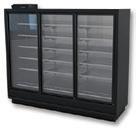



Some people still think Southern CaseArts only produces the world’s best custom display cases. In reality, we offer a remarkable range of in-stock designs for every section of your store. Hot, Cold, Frozen, Ambient…whatever your need we have options that maximize packout and encourage sales. Bakery, Meat, Hot Foods & Soup, Beverages and more, discover today’s Southern CaseArts, where quality and reliability for the long-term is absolutely unmistakable.
PROJECT MANAGEMENT/PRODUCTION/ART
ART DIRECTOR Bill Antkowiak bantkowiak@ensembleiq.com
ADVERTISING/PRODUCTION MANAGER Jackie Batson 224-632-8183 jbatson@ensembleiq.com
MARKETING MANAGER Krista-Alana Travis ktravis@ensembleiq.com
SUBSCRIPTION SERVICES
LIST RENTAL mbriganti@anteriad.com SUBSCRIPTION QUESTIONS contact@progressivegrocer.com
CORPORATE OFFICERS
CHIEF EXECUTIVE OFFICER Jennifer Litterick
CHIEF FINANCIAL OFFICER Jane Volland
CHIEF OPERATING OFFICER Derek Estey
CHIEF PEOPLE OFFICER Ann Jadown
CHIEF STRATEGY OFFICER Joe Territo
PROGRESSIVE GROCER (ISSN 0033-0787, USPS 920-600) is published monthly, except for July/August and November/December, which are double issues, by EnsembleIQ, 8550 W. Bryn Mawr Ave. Ste. 225, Chicago, IL 60631. Single copy price $17, except selected special issues. Foreign single copy price $20.40, except selected special issues. Subscription: $150 a year; $276 for a two year supscription; Canada/Mexico $204 for a one year supscription; $390 for a two year supscription (Canada Post Publications Mail Agreement No. 40031729. Foreign $204 a one year supscrption; $390 for a two year supscription (call for air mail rates). Digital Subscription: $87 one year supscription; $161 two year supscription. Periodicals postage paid at Chicago, IL 60631 and additional mailing offices.
Printed in USA. POSTMASTER: Send all address changes to brand, 8550 W. Bryn Mawr Ave. Ste. 225, Chicago, IL 60631. Copyright ©2024 EnsembleIQ All rights reserved, including the rights to reproduce in whole or in part. All letters to the editors of this magazine will be treated as having been submitted for publication. The magazine reserves the right to edit and abridge them. The publication is available in microform from University Microfilms International, 300 North Zeeb Road, Ann Arbor, MI 48106. The contents of this publication may not be reproduced in whole or in part without the consent of the publisher. The publisher is not responsible for product claims and representations.
southerncasearts.com | 800.552.6283
FROZEN
AMBIENT
HOT COLD
Premium. Outstanding. Authentic.

S tock GOYA® Extra Virgin Olive Oil , winner of the ChefsBest Excellence Award * . Your shoppers will taste the exceptional quality that sets our single-origin Spanish olive oil apart from the competition.
authenticity.
Award-winning
©2023 Goya Foods, Inc. Learn More! Contact your GOYA representative or email salesinfo@goya.com | trade.goya.com * Earned by products that surpass quality standards established by professional chefs.
By Gina Acosta
Stopping Mergers Won’t Save Grocery Stores
IT WILL, HOWEVER, HURT THE TRADITIONAL SUPERMARKET RETAILERS THAT WE ALL WANT TO SEE THRIVE.
rocery stores are the lifeblood of the community.
They are an essential service, like firefighters and hospitals.
So why is everyone suddenly attacking grocers as greedy profiteers looking to stomp on workers and consumers?
Well, it’s an election year. The Biden administration has made a national pastime of calling out retailers and consumer goods companies for postCOVID prices being higher and packages being smaller. Plus, the days of consumer love for grocery retailers being “heroes” (as during the pandemic) are far behind us. That’s my reaction to the news that the Federal Trade Commission has sued to block Kroger’s merger with Albertsons.
Anyone with a bit of business sense knows that this merger will allow the two companies to achieve greater scale to better compete with the discounters eating away at their shrinking share of grocery sales. The merger will also allow the new, larger company to consolidate operations, cut expenses, reduce costs and negotiate lower prices with suppliers — all of which will benefit consumers and workers.
Blocking this merger will not stop high prices, consolidation or job losses in the traditional grocery industry. But blocking this merger will hurt the traditional supermarket retailers that we all want to see thrive, including Kroger and Albertsons, to the detriment of workers and consumers.
As former U.S. Rep. Kurt Schrader, D-Ore., wrote in the Portland Tribune: “Competition is good for business and consumers, but there must be a level playing field. America’s supermarket grocers need to have the option to get bigger in order to better compete, drive down prices, and protect good-paying, American union jobs.”
Putting aside the political theater, the FTC, Kroger and Albertsons all have highly experienced legal teams fighting this out in court, and the transaction deserves intense scrutiny into whether monopolistic and restrictive trade practices might ensue with a merged company.
According to Reuters, the FTC’s lawsuit was assigned to U.S. District Judge Adrienne Nelson, a former Oregon Supreme Court justice who was confirmed to the federal bench in February 2023. Nelson was a public defender in the late 1990s and then worked in private practice from 1999 to 2004 at the worker-focused labor and employment firm Bennett Hartman, where her clients included labor unions. A Reuters search of U.S. court cases in Oregon didn’t yield records of any other antitrust cases before Nelson, who likely won’t be scheduling a hearing on the matter for months. A protracted litigation timeline seems certain.
In the end, I believe the two sides will eventually hash out terms seen as more beneficial for workers and consumers (divesting more stores, selling more assets, etc.), and the $24.6 billion deal will go through.
PG’s Editorial Advisory Board
Progressive Grocer has been fortunate for more than 100 years to cover this industry, and we want to see every grocery retailer thrive. With the Kroger-Albertsons deal — the biggest merger ever in the U.S. grocery sector — in the crosshairs, and so much other important news happening in this industry, PG is pleased to announce the creation of a new Editorial Advisory Board in 2024. The Editorial Advisory Board will bring highly respected and accomplished professionals in the grocery industry to advise and review the direction of PG content, with the aim of widening our reach and enhancing the quality of our offering to you, our cherished reader.
Progressive Grocer’s Editorial Advisory Board members are:
Lynette Ackley, Group VP Merchandising, HBC, Consumables and Hardlines, Meijer
Charles D’Amour, Executive Chairman, Big Y Foods
Ryan Draude, Head of Loyalty, Giant Food
Zachary Lane, Director of Retail Systems, Fareway Stores
Kevin Miller, Chief Marketing Of cer, The Fresh Market
Diana Marshall, Chief Growth Of cer, Sam’s Club
Ryan Roberts, EVP of Perishables, Hy-Vee
Rachel Shemirani, VP, Barons Markets
But we don’t just want to hear from our new board. We want to hear from you. Let us know what you think about the Kroger-Albertsons deal and other pressing issues of the day in grocery, as well as how we can do better in shining a light on them.
 Gina Acosta Editor-In-Chief gacosta@ensembleiq.com
Gina Acosta Editor-In-Chief gacosta@ensembleiq.com
6 progressivegrocer.com EDITOR’S NOTE











































Calendar 05.24
National Asparagus Month
National Dental Care Month
National Egg Month
National Hamburger Month
1 National Chocolate Parfait Day. Customers can dig into an easy-tomake version of this indulgent dessert.
5 Orthodox Easter. Have the traditional foodstuffs on hand for those who observe this joyous holiday according to the Julian calendar.
6
National Beverage Day. Increase your grab-and-go chilled displays to quench every thirst.
12
Mother’s Day. Encourage shoppers to show their love for Mom with flowers, candy, greeting cards and more.

19
Stepmother’s Day
For all of those people who get along great with their “bonus moms,” provide gifts they can bring with them on a visit.
13

Cough Drop Day. It’s smart to have these on hand in advance of cold and flu season.

20
World Bee Day. Spotlight the ways that you’re helping pollinator populations recover.
7
National Roast Leg of Lamb Day. Provide step-bystep instructions for nervous home cooks to get this classic dish right.

8 National Give Someone a Cupcake Day. Your in-store bakery is just the place to find a mouth-watering selection for gifting.
2
World Tuna Day. Make shoppers aware of your sustainable seafood sourcing practices.
3
National Military Appreciation Month
National Salad Month
National Salsa Month
National Strawberry Month
National Montana Day. Turn the spotlight on food and beverage suppliers from Big Sky Country.

9

10
4
Dave Brubeck Day. Encourage shoppers and associates alike to “Take Five” for the duration of this infectious jazz classic.

11
26
National Redhead Day. This is the time to celebrate gingers by birth or choice
14

15

National Dance Like a Chicken Day. We know our friends at Lowes Foods know how to do it!

21
World Meditation Day. Invite an instructor to teach your workforce how to lower stress and achieve calm through this time-honored practice.
National Safety Dose Day. Request that your pharmacy team explain to consumers the importance of adhering to correct medication amounts.
National Sleepover Day. Those spending the night with their besties can find their snacks, drinks and hair products in your aisles.

16
Supply Chain Professionals Day. They deserve our heartfelt appreciation for getting products to stores.
National Shrimp Day. Lure customers to the seafood counter with great deals on this beloved crustacean.

17
National Walnut Day. Bake with it, snack on it, sprinkle it on salads – it’s a nut for many occasions.


Stamp Out Hunger Food Drive Day. Enlist associates and the public to help their food-insecure neighbors with donations to area organizations.
18
National Cheese Soufflé Day. Present a product demo to show shoppers they shouldn’t be afraid to make one themselves.
22
23
24

27
Memorial Day
National Grape Popsicle Day. As the weather starts to heat up, these really hit the spot.

National Vanilla Pudding Day Those who don’t want to make one from scratch can use a time-saving mix.

28
World Passion Fruit Martini Day. Raise a glass to exotically flavored cocktails.


29

National Paperclip Day. It’s always a good idea to stock up on these – you never know when you’ll need one.

Lucky Penny Day. We know some people want to get rid of this denomination, but we always pick one up when we find one.

30
Fakesgiving. Consider it just another occasion to get together with friends and family.
National Cooler Day. Remind shoppers to fill theirs with soft drinks, beer and other items best consumed cold.
31

Web Designer Day. Thank yours for your awesome internet site.
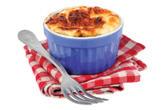
25
National Italian Beef Day. When in Chicago, seek out this iconic delicacy.

S M T W T F S IN-STORE EVENTS
8 progressivegrocer.com












for all salty snack products, up 7.0% compared with a year ago
for variety packs, up 4.5% compared with a year ago
for meat snacks, up 8.2% compared with a year ago
for pita chips, up 8.6% compared with a year ago
Source:
10 progressivegrocer.com FRONT END Shelf Stoppers Salty Snacks Latest 52 WksW/E 01/29/24 Latest 52 WksW/E 01/29/24 Latest 52 Wks YAW/E 01/28//23 Latest 52 Wks YAW/E 01/28//23 Latest 52 Wks 2YAW/E 01/27/22 Latest 52 Wks 2YAW/E 01/27/22 Average Unit Prices
is the average unit price for salty snack products versus the year-ago period? Source: NIQ, Total U.S. (All outlets combined) – includes grocery stores, drug stores, mass merchandisers, select dollar stores, select warehouse clubs and military commissaries (DeCA)
What
NIQ, Total U.S. (All outlets combined) — includes grocery stores, drug stores, mass merchandisers, select dollar stores, select warehouse clubs and military commissaries (DeCA) Potato Chips Tortilla Chips Popcorn Variety Packs Cheese Snacks Total Department Performance Top Salty Snack Categories by Dollar Sales $35,761,927,683 $33,823,246,426 $29,662,711,646 Salty Snacks Generational Snapshot Which cohort is spending, on average, the most per trip on tortilla chips? Millennials $5.62 Gen Xers $5.49 Boomers $5.10 The Greatest Generation $4.86 Source: NielsenIQ Panel On Demand Homescan, Total U.S., 52 weeks ending Nov. 25, 2023 $3.94
$13.16
$5.28
$4.88
Index by Age and Presence of Children $9,000,000,000 8,000,000,000 7,000,000,000 6,000,000,000 5,000,000,000 4,000,000,000 3,000,000,000 2,000,000,000 1,000,000,000 0 Salty Potato Cheese Tortilla Snacks Chips Popcorn Snacks Chips Children Under 6 Only 96 84 85 106 101 Children 6-17 Only 137 126 125 129 162 Children Under 6 and 6-17 133 116 123 156 151 No Children 88 94 93 87 80

Dairy and Nondairy Milk
What You Need to Know
Consumers find value in dairy and nondairy milks, which drives consumption of both. Both categories are on the rise, finding their way into applications beyond traditional uses. Personalization is key as dairy and nondairy milks gain popularity for their versatility and ability to cater to varying dietary preferences.
Improved product attributes (other than low price) aren’t enough to increase usage for most. Opportunity lies in highlighting novel use cases to attract new consumers and expand reach. Developing formats for portability and highlighting milk use cases in skin care can add value to time- and money-strapped consumers.
Consumers see milk as a staple, but are increasingly price sensitive and willing to trade down to cheaper brands. Rising prices from inflation, exacerbated by supply-side issues related to climate change and increased production costs, may not force consumers out of the category, but they affect their milk shopping habits.
Consumer Trends: Key Takeaways
As inflation puts constraints on grocery spending, there’s a heightened emphasis on value. Within this category, the simplicity of dairy milk aids in regaining share lost to nondairy products. With its familiar taste and trusted health image, consumers, especially younger audiences, are increasingly turning back to dairy.


When consumers choose dairy or nondairy milks, the decision is an extension of their values. Brands on either side have the opportunity to partner with consumers on matters they care about. Whether it’s health or sustainability, consumers want clear communication about how milk can fill their needs and help them meet their goals.
Consumers opt for dairy and nondairy milks for diverse reasons, valuing both for their unique attributes. These sought-after options cater to consumer demands for health, sustainability, taste and allergenfree benefits, driving increased purchases of both varieties rather than that they choose one over the other.




Opportunities

Consumers are familiar with the versatility of milk, yet there’s still potential to expand on its possibilities. From incorporating milk into a face mask to using oatmilk in savory recipes, showcasing new applications can alleviate concerns about shelf life and higher prices while encouraging exploration of new milk-based experiences.
As consumers turn to dairy and nondairy milks for diverse reasons, it’s essential to shift marketing toward highlighting their unique qualities instead of promoting one as superior. By emphasizing their distinctive factors, both segments can thrive as separate high-value categories and cater to varying consumer preferences.
Position dairy and nondairy milks as specialty beverages that can meet a variety of needs to open up new markets. Target parents with milks containing nutrients for development, reach athletes with performance-based formulations and portable packaging, and support athome baristas with nondairy milks capable of frothing.


PROGRESSIVE GROCER March 2024 11 MINTEL CATEGORY INSIGHTS Global New Products Database
FOR MORE INFORMATION, VISIT WWW.MINTEL.COM OR CALL 800-932-0400
ALL’S WELLNESS
By Diane Quagliani, MBA, RDN, LDN
Getting the Most Out of Health-andWellness Tech
WITH HELP FROM RETAIL DIETITIANS, GROCERS CAN NOW SERVE UP PERSONALIZED INFORMATION.

hree important factors make the environment right for using health-andwellness technology to reach shoppers with personalized information. First, more than eight in 10, or 82% of, American consumers consider wellness a top or important priority in their everyday lives, according to the 2023 McKinsey
Future of Wellness Survey. Second, apps and wearable health-tracking devices are popular with American adults, with about 40% using apps and 35% using wearable devices, a 2023 Morning Consult survey found. Finally, nearly one in five American consumers and one in three American Millennials prefer personalized products and services, according to McKinsey.
Retailers on Board



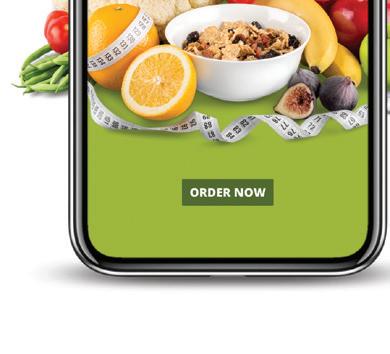
Retail dietitians lend accuracy and credibility to the personalized nutrition data that shoppers receive via apps and websites.
An increasing number of retailers are delivering personalized health-and-wellness information to shoppers through their apps and websites.
One example is Albertsons Cos.’ Sincerely Health digital health-and-wellness platform, which encompasses several aspects of well-being. To start, shoppers complete a questionnaire that measures their personalized Health Score based on seven dimensions of well-being: nutrition, activity, sleep, physical health, mental well-being, mindfulness and healthy habits. Shoppers can link their activity trackers to the platform, and set and track health goals related to nutrition, activity, sleep and lifestyle. A nutrition insights tool calculates how many of a shopper’s food purchases meet USDA MyPlate dietary guidance, and provides personalized food recommendations, recipes and articles.
For signing up to Sincerely Health, shoppers receive an incentive of up to $25 off future grocery purchases. As shoppers reach their health goals, they receive Healthy Points to redeem for coupons on nutritious foods and beverages such as fresh and frozen fruits and vegetables, nuts, and bottled water. Shoppers may also link their pharmacy account to the platform.
Retail Dietitians a Ready Resource
Grocers can call on their retail dietitians whenever health-and-wellness tech channels include food and nutrition components. Retail dietitians are key for providing personalized information, both directly to shoppers through online consultations and classes, and indirectly as content advisors and developers.
For instance, H-E-B dietitians provide telehealth visits that offer shoppers interactive features like sharing their pantry or taking a virtual shopping tour. Meijer’s new virtual personalized nutrition coaching service gives shoppers
progressivegrocer.com
the convenience of receiving several nutrition services online from a Meijer registered dietitian. Depending on an individual’s needs, dietitians may provide assessment, monitoring and evaluation based on diet, lifestyle, medical history and nutritional needs, nutrition education and personalized meal plans, nutritional coaching for health conditions such as diabetes and cardiovascular issues, food allergy management, weight management, and behavior change support.
Behind the scenes, retail dietitians lend accuracy and credibility to the personalized nutrition data that shoppers receive via apps and websites. Among other things, dietitians work on the nutrition aspects of health scoring systems; create nutrition content for health platforms, including articles, meal plans, tips, shopping lists and recipes; provide specialized information for shoppers with health concerns (diabetes, heart health, weight management, etc.); and develop product nutrition criteria for foods and online product filters (gluten-free, high-protein, vegetarian, etc.).
Diane Quagliani, MBA, RDN, LDN, specializes in nutrition communications for consumer and health professional audiences. She has assisted national retailers and CPGs with nutrition strategy, web content development, trade show exhibiting, and the creation and implementation of shelf tag programs.
12















A SIP OF THE BTBSaratogasales@bluetriton.com Contact your BlueTriton account representative for more information or contact us directly. ©
75th Consumer Expenditures Study

PG’s 75th Consumer Expenditures Study goes directly to shoppers to explore not only what they’re buying in supermarkets, but also why they’re making certain decisions.
By Jenny McTaggart
raditionally, Progressive Grocer’s annual Consumer Expenditures Study (CES) has reported on the top-selling categories in supermarkets around the country, essentially looking at what consumers are buying in terms of dollars spent and units sold.
For the 75th CES, however, we’re doing things a bit differently. This time, we went directly to grocery shoppers — 1,001 of them, to be exact — to find out not only what they’re buying, but also where they’re buying groceries, why they choose the stores they do, what they like and don’t like about the shopping experience, and other factors that go into their decision-making. In this way, our updated study takes the pulse on consumers’ attitudes on their path to purchase. The 75th CES, as presented in the following pages, will be a benchmark study for the magazine going forward, with the aim of establishing a measurable baseline for understanding grocery shoppers’ preferences and behaviors in the years ahead.
In addition, the study takes a deep dive into generational insights, as well as differences between male and female
shoppers and among major geographical regions. For any grocery retailer operating today, it’s crucial to recognize these differences and to make sure that you’re offering different things for different shoppers. You can’t be one store to all people, so it’s important to reach shoppers differently at the various stages of their lives, ideally while presenting one unified brand message.
Methodology
The survey for Progressive Grocer’s 75 th Consumer Expenditures Study was fielded Jan. 10-15, 2024, and includes responses from 1,001 grocery store shoppers ages 18 and up. To qualify, respondents had to identify as U.S. residents who shop at grocery stores at least once a month and serve as the primary or shared decision-maker for grocery shopping in their households. The average household income of respondents was $68,230.
14 progressivegrocer.com COVER STORY
Major Themes of the 75th CES
Before we get into the details of the study, here are a few major recurring themes and key insights:
Inflation continues to have a big impact on shoppers’ behavior and has led them to buy less in the past year. Price is now their No. 1 factor in choosing where to shop, though product quality, finding items in stock and other attributes are still important.
The traditional grocery store is still the primary place where people regularly purchase groceries, but alternative formats — including online shopping — continue to gain steam. A little more than half admit that they shop at three stores regularly.
Prepared foods is a growth opportunity for retailers, and younger consumers in particular are interested in convenient meals and trying new things (but price still comes into play).
Most shoppers now self-identify as “health-conscious,” and some are willing to switch stores over sustainability issues.
The categories most frequently purchased at a grocery store within the past month include dairy, fresh produce, bread/bakery items, salty snacks and fresh meat/seafood. When it comes to private label, key categories are dairy, paper products, canned vegetables and fruits, bread/bakery items, and household products.
These are just a few of the study highlights — keep reading to learn more.
Store Preferences:
Traditional Chains Still Rule
With all of the talk regarding online retailing and alternative formats, it’s important to note that the traditional grocery chain still rules, at least among respondents to this survey, which was fielded in January. A huge number — 89% — visit a traditional grocery chain at least once a week (and the figure jumped to 92% among consumers living in the western United States). Mass merchandisers and supercenters are close behind, with 81% visiting at least once a week.
Still, nontraditional formats are definitely gaining ground nationwide. About half of those surveyed said that they purchase grocery items at dollar stores, drug stores or
Top Categories Purchased
What consumers tell us they’re purchasing matches up pretty closely with the latest sales data from NielsenIQ and other sources. In PG’s 75th CES, the categories most frequently purchased at a grocery store within the past month include dairy (milk, eggs and cheese), at 86%; fresh produce (85%); bread/bakery items (82%); salty snacks (78%); and fresh meat/seafood (75%). Looking at generational differences, Gen Zers and Millennials are more likely to have purchased prepared foods, energy drinks, functional beverages and baby food. Meanwhile, females overindexed on purchases of fresh produce, shelf-stable grains, cooking fats, baking supplies, confectionery and pet food, suggesting that many of them are likely still the bakers (and primary shoppers) in their households.
Edible Categories Purchased at a Grocery Store in the Past Month
pet food.
PROGRESSIVE GROCER March 2024 15 86% 85% 82% 78% 75% 68% 66% 62% 61% 60% 58% 58% 56% 55% 54% 50% 46% 46% 45% 40% 39% 32% 28% 23% 22% 17% 16% 9% 7% 3%
Gen Zers and Millennials are more likely than Gen Xers and Boomers to have purchased prepared foods, energy drinks, functional beverages and baby food. Females are more likely than males to have purchased fresh produce, shelf-stable grains, cooking fats, baking supplies, confectionery and
0% 20% 40% 60% 80% 100%
75th Consumer Expenditures Study
Nonedible Categories Purchased at a Grocery Store in the Past Month
with 2.5 average prepared food purchase occasions in the past month.
Types of Prepared Foods Purchased at a Grocery Store in the Past Month
Gen Zers and Millennials are significantly more likely than Boomers to purchase prepared cold entrées, prepared hot sides, prepared appetizers/snacks, prepared soups and prepared platters.
Today’s average spend for a grocery trip
discount grocery chains on a weekly basis, while 48% are shopping at club stores. Additionally, just under half of shoppers (47%) go online at least once a week for their grocery shop. Meanwhile, independent grocery stores are bringing in fewer shoppers than other formats (43%), although shoppers living in the eastern United States shop these stores a bit more (47% visit weekly).
Lower Prices Are Top of Mind as Inflation Lingers
With inflation on most Americans’ minds, it isn’t surprising that price comes in as the No. 1 factor for choosing where to shop, with four in five shoppers (83%) and an impressive 90% of Baby Boomers selecting this attribute. They still care about quality, too, though: Following price, other key factors include product quality (71%), freshness of products (69%), products in stock (69%), convenient location (64%), variety of products (64%), and sales and promotions (59%).
As for how shoppers today define value, while there are differing opinions, a solid onethird said that value is “a good-quality product for a good/fair price,” while 22% thought solely of “best/lowest price.” Meanwhile, 38% preferred a good price over product quality (for Gen Z shoppers, that number jumps to 55%).
Selecting Factor When Picking a Grocery
16 progressivegrocer.com
purchased prepared foods at grocery in the past month, 70% of shoppers agree with the statement: “I am health conscious.”
67%
66% 62% 58% 50% 37% 25% 24% 23% 11% 10% 10% 9% 5% 11% Gen Zers and Millennials are more likely than Gen Xers and Boomers to have purchased personal/household sanitizing products, pet supplies, toys/games, office supplies, books/ magazines and diapers/baby supplies.
more likely
males to have purchased personal/ household sanitizing products, beauty products, pet supplies and books/magazines. COVER STORY
Females are
than
Store Price 83% Product Quality 71% Freshness of Products 69% Products in Stock 69% Convenient Location 64% Variety of Products 64% Sales and Promotions 59% Store Cleanliness 58% Store-Brand Quality 53% Brands Offered 42% Helpful/Friendly Employees 40% Rewards/Loyalty Program 40% Organization of Store 32% Speed of Shopping Trip 29% Local Product Selection 26% Healthy/Better-for-You Products 25%
Prepared Hot Entrées (rotisserie/fried chicken, salmon, lasagna) 53% Baked Goods Baked In-Store (bread, rolls, pie, brownies) 33% Prepared Cold Sides (pasta salad, potato salad, bean salad) 26% Prepared Hot Sides (mac and cheese, mashed potatoes, French fries) 25% Prepared Appetizers/Snacks (wings, potstickers, egg rolls) 24% Prepared Cold Entrées (chicken, poke bowls, sushi) 21% Prepared Entrée Salads 16% Prepared Platters (cheese, fruit, vegetables) 13% Prepared Soups 12%

















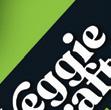






















PROGRESSIVE GROCER March 2024 17 Grocery Shopping Frequency by Store Type Grocery Shopping Frequency by Store Type: Other Formats TRADITIONAL CHAIN GROCERY STORE DISCOUNT CHAIN GROCERY STORE MASS / SUPERCENTER INDEPENDENT GROCERY STORE 6% Never Shop 27% Never Shop 5% Never Shop 33% Never Shop 55% 53% 48% 47% 47% 43% 31% 31% 29% 34% 34% 20% 20% 31% Shop Once/Week+ Never Shop Shop Once/Week+ Never Shop drop in LIKE IT’S try all of our HOT NEW PRODUCTS & FLAVORS GLUTEN FREE NON-GMO *PRODUCT EXCLUSIONS APPLY BOOTH N904 EXPO WEST Anaheim, CA • March 13 -15 Contact Your Representative Today! 1 (855) 923-4299
75th Consumer Expenditures Study
Shopping Behaviors: Most Plan Ahead but Appreciate Meal Inspo
Today’s shoppers want it all: They prefer to plan ahead and stock up on their grocery runs, but they also want to get in and out of the store quickly. One-fifth admitted to being more of an “impulsive buyer,” with Gen Zers and Millennials significantly more likely to fall into this camp. Meanwhile, just over a third (35%) agreed that they like to take more time to browse the store. Looking ahead to 2025, shoppers didn’t anticipate significant changes in these behaviors.
An impressive 63% said that they make a shopping list, but at the same time they’re open to making additional purchases once they enter the store. (Only 20% don’t make a list.)
In-Store Versus Online
Nearly all respondents (95%) said that they had shopped in-store for groceries in the past month, but online shopping is proving to be a regular routine these days, with one-fifth purchasing online for in-person delivery or curbside pickup. Across all trips, on average, 79% are completed in the store. When asked if they have a preference for shopping in-store or online, 72% still gravitated toward the store, but a small percentage (14%) were leaning toward online purchases a year from now.
Over the next year, most expected their purchase methods to remain consistent, although one-fifth thought that they’ll do more in-store shopping and 11% expected their online usage to ramp up. Baby Boomers are the least likely to make the switch to online shopping, while Gen Zers and Millennials said that they’ll shop “more” in both the physical store and online, using both contactless delivery and in-store pickup.
Prepared Foods Presents Growth Opportunity
Prepared foods continued to account for a healthy part of the grocery business. The category was purchased by two-thirds of shoppers in the past month, with an average of 2.5 purchase occasions. Gen Zers and Millennials bought these foods significantly more than Gen Xers and Boomers, and shoppers in the
State of Food Inflation: Today Versus One Year from Now
In-store Versus Online: Anticipated Use One Year from Now
Gen Zers and Millennials are more likely than Gen Xers and Boomers to say that they will shop “more” one year from now these ways: in-store, online for contactless delivery, online for in-store pickup.
Boomers are more likely than all other generations to say that they will “not shop this way”: online for contactless delivery, online for in-store pickup, online for in-person delivery, online for curbside pickup.
Males are more likely than females to say that they will “not shop this way”: online for in-store pickup, online for curbside pickup.
West were also overindexing. Among those who didn’t purchase prepared foods, 44% find them too expensive, 39% prefer to purchase somewhere else or cook at home, and 37% just don’t have prepared foods in mind when they visit the supermarket.
Health and Sustainability Concerns Affect Decisions
In case anyone is still wondering, health and sustainability have definitely hit the mainstream among American shoppers. In this study, a substantial seven in 10 shoppers self-identified as “health conscious.” For Millennials and Boomers, that number jumped to 75%, and among shoppers living in the Northeast, the figure was 77%. The good news is that just over half of
health-conscious shoppers said that they’re either extremely or very satisfied with their store’s selection.
As for sustainability issues, most shoppers indicated interest in nearly all sustainable practices, with EVcharging stations being the exception (55% said that they’re “not concerned,” although Gen Zers, Millennials and males were more likely to show interest than other groups). More than half would like to see their stores donate food instead of throwing it out (54% saw this as a “really important” practice, with Gen Zers favoring it the most). In addition, recycling, ethical sourcing, and zero waste goals were viewed as “really important” by just over one-third of shoppers.
18 progressivegrocer.com
COVER STORY
2% 46% 48% 46% 49% Shopping in Store Today Versus Year Ago Predicted One Year From Now Buy Online/ Contactless Delivery Buy Online for In-Store Pickup Buy Online for Delivery Buy Online for Curbside Pickup 20% 12% 11% 11% 10% 71% 36% 36% 37% 35% 7% 7% 6% 7% 6% More About Same Less Will Not Shop This Way Better About Same Worse
58% 43% 12% 17% 30% 40%


Sea of Convenience
FROZEN AND SHELF-STABLE OPTIONS SHOULD BE PROMOTED AS GREAT CHOICES FOR INFLATION-WEARY AND COOKING-AVERSE CONSUMERS.
By Bridget Goldschmidt
hen consumers — and many retailers — think of seafood, they normally envision fresh departments stocked with just-caught product displayed on ice, but frozen and shelf-stable options can play a key role in boosting seafood sales, particularly at a time when shoppers are seeking value.
“The current economic situation has definitely opened up the opportunity for frozen and shelf-stable seafood items as consumers are oftentimes looking to buy in bulk,” affirms Lilani Dunn, the newly named executive director of the Anchorage, Alaska-based Bristol Bay Regional Seafood Development Association (BBRSDA), a fisherman-funded group. “Both frozen and shelf-stable seafood also are great options for trending consumer issues such as food waste and quickness of ease of meal preparation.”
“Frozen and shelf-stable saw great gains during the pandemic,” notes Kayla Bennett, media and communications manager at the National Fisheries Institute (NFI), a Reston, Va.-based industry trade group, who goes on to cite recent statistics from Circana and 210 Analytics. “We are seeing some headwinds across all seafood categories, attributed to inflation. But we’re head and shoulders above where we were pre-pandemic. Frozen is down 3.1% from 2022, but up 32.4% since 2019. Meanwhile, the shelf-stable side is up 13.1% from 2019 and increased 0.2% in 2023. We’re not seeing the explosive growth we saw in 2020 or 2021, but overall, we’re trending in a very positive direction.”
“A Matter of Perception”
To get the message across to consumers that frozen and shelf-stable seafood products are great choices, retailers must change shoppers’ ideas about such products.
“While we know that frozen and shelf-stable seafood increasingly delivers on both value and quality, and can be just as nutritious as fresh seafood, it truly is a matter of perception,” advises Athena Davis, marketing manager at the Wilmington, N.C.-based Aquaculture Stewardship Council (ASC) North America. “When it comes to marketing frozen and shelf-stable products, we think sustainable
Key Takeaways
The current economic situation, along with such consumer concerns as food waste and ease of preparation, has opened up the opportunity for frozen and shelfstable seafood items.
When marketing frozen and shelfstable seafood, retailers must change shoppers’ perceptions about these products.
Gen Alpha should be a main focus of forthcoming frozen and shelf-stable seafood product promotions.
PROGRESSIVE GROCER March 2024 19 SOLUTIONS Seafood Forecast
The Bristol Bay Regional Seafood Development Association has conducted chef demos at food retailers to highlight the ease of preparation of frozen sockeye salmon items.
Seafood Forecast
and responsible sourcing are key factors for brands looking to differentiate and communicate their product benefits to shoppers. We know firsthand that retailers and seafood producers are seeing increased demand for more traceable and responsibly sourced seafood products, and that ASC’s certification is a valuable marketing point for frozen and shelf-stable products.”
Among the retailers that are effectively promoting such products, ASC singles out one that it partnered with last October on a National Seafood Month promotion. “We think New Seasons Market, in Portland, Ore., does an excellent job of merchandising shelf-stable seafood,” says Davis. “When you walk up to their fresh seafood case, you’re met with a bold display of trendy, colorful and premium tinned seafood products right beside the case.”
“Tinned fish is having its moment with younger audiences,” notes NFI’s Bennett. “If you don’t understand the hype, you only have to go as far as TikTok to see this trend firsthand. Meanwhile, canned and
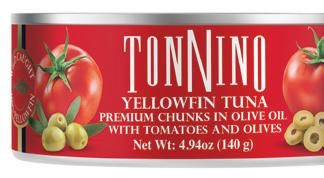

“Tinned fi sh is having its moment with younger audiences. If you don’t understand the hype, you only have to go as far as TikTok to see this trend fi rsthand.”
—Kayla Bennett, National Fisheries Institute
pouched products emphasize convenience and value, which are evergreen with consumers.”
In ASC’s work with brands across North America as part of a multiyear marketing campaign to build awareness and understanding of the value behind its certification and label, it has recently “seen a significant increase in producers and brands staking a bigger claim in shelf-stable and frozen spaces, whether through new product launches or brand extensions,” notes Davis.
Speaking of frozen, BBRSDA has “partnered with retailers across the country, conducting chef demos at Sprouts, Harris Teeter and QFC,” says Dunn. “These demos help educate consumers [about] the ease of prep, introduce them to frozen sockeye salmon items offered, and also are paired with printed and digital assets that lead to recipes, cooking tips and other differentiators of our Wild Sockeye Salmon from Bristol Bay, Alaska, such as nutrition, place of origin, and the support of local U.S. fishers.”
She adds: “A frozen side or portion of sockeye salmon is a perfect starting point for any skill level of the at-home

20 progressivegrocer.com SOLUTIONS
The tinned seafood segment has been offering a greater number of premium products of late.

Canned and pouched seafood products emphasize convenience and value, making them attractive to consumers.
cook. We have a collection of Fast, Wild and Easy recipes that have few ingredients, which are typically found in household pantries. We also have a Salmon Cooking Guide that includes various cooking methods, as well as tips on how to handle working with frozen salmon.”
Riding the Frozen and Shelf-Stable Wave
Regarding how to leverage future trends in the frozen and shelf-stable seafood segments, Dunn asserts: “Gen Alpha should be a main focus for forthcoming frozen and shelf-stable seafood products. Not only will they be the buyers for their own households, but the benefits of
Why Frozen and Shelf-Stable Seafood?
What makes frozen and shelf-stable seafood products particularly appropriate options for today’s consumers?
“Shoppers … may be looking for better price points, or being mindful that there’s less chance of food and food dollar waste when you buy frozen and shelf-stable proteins,” observes Athena Davis, marketing manager at the Wilmington, N.C.-based Aquaculture Stewardship Council North America.
Davis goes on to cite recent FMI seafood research highlighting several factors that may be contributing to this greater shopper appeal: At-home food commands more of the food dollar.
Lower-prep dinners are gaining in importance.
Value-added seafood is a major contributor

PROGRESSIVE GROCER March 2024 21
FRESH PRECUT ATLANTIC SALMON PORTIONS © 2024 MOWI USA, LLC. ALL RIGHTS RESERVED. MARINE HARVEST AND MOWI ARE REGISTERED TRADEMARKS OWNED BY MARINE HARVEST HOLDING AS.
Holiday Entertainment Guide
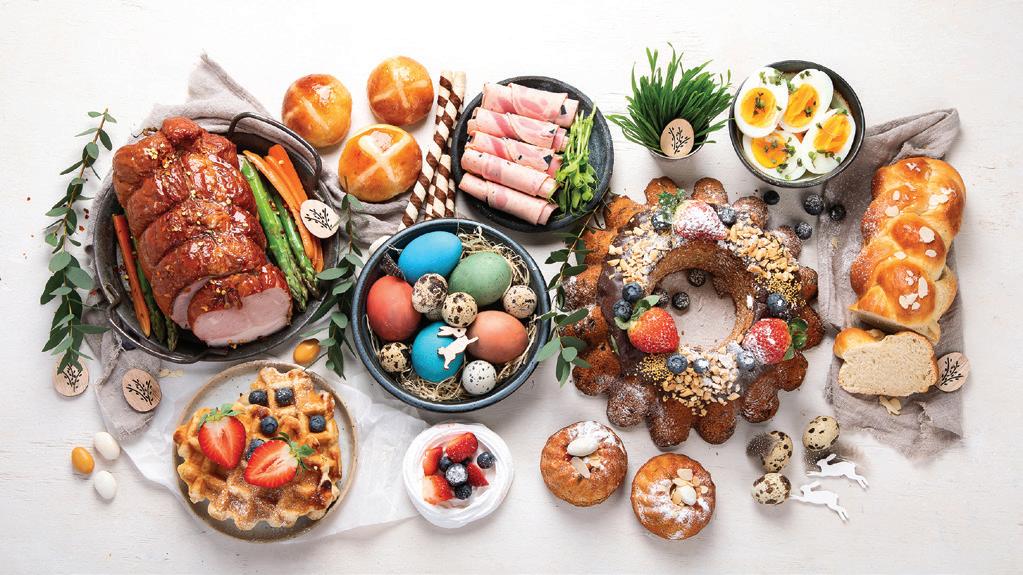
Party Central
GROCERS AND BRANDS OFFER A HOST OF SOLUTIONS FOR CELEBRATIONS THAT DRAW SHOPPERS
By Lynn Petrak
here’s pretty much an observance for everything these days — like National Melba Toast Day (March 23) and National Crayon Day (March 31) — but retailers do have several key opportunities to lift sales for popular upcoming holidays.
Following a busy February in which the Super Bowl, Mardi Gras, Ash Wednesday and Valentine’s Day took place in rapid succession, grocers are redirecting their assortments and promotions for spring and early-summer holidays that involve at-home entertaining. Looking ahead, plans are already in motion for the peak holiday season in the fourth quarter.
Party On
To be sure, U.S. consumers like special occasions. According to the “2024 Holiday Intentions” study from Chicago-based data and tech company Numerator, nearly all consumers said that they’ll buy something for holiday celebrations. Nine in 10 shoppers said that they’ll make a purchase related to a given holiday, and a third expected to spend between $50 and $100 per holiday throughout the year.
Numerator’s data also affirmed that supermarkets are top shopping destinations for holidays. As for what consumers are buying when they’re in stores or online, the insights company found that food is the most popular item that
shoppers intended to purchase for 10 of the 14 major holidays, followed by alcohol.
While they’re spending on food, drink and other supplies for holiday celebrations, shoppers remain mindful of elevated prices, even as inflation has declined from its 2022 peak. “Beyond inflation, 2023 was a difficult year for consumers,” observes Mike Scavuzzo, sales director, emerging brands at Numerator. “The end of SNAP benefits and the return of student loan payments put even more pressure on consumer spending that will likely carry into 2024.”
Mike Kostyo, VP at Chicago-based food industry consulting firm Menu Matters, agrees
Key Takeaways
To appeal to consumers planning to celebrate spring holidays with varying degrees of budgets, grocers offer a range of meal solutions and catering options.
Given the season, grilling and outdoor food and beverage staples are at the heart of retail features and promos.
Beyond the standard holidays, retailers can aim to boost sales by highlighting other occasions that warrant some kind of entertaining.

22 progressivegrocer.com SOLUTIONS



! Email sales@buzzballz com to learn more ©2024 BuzzBallz, LLC, Carrollton, TX Please Enjoy Responsibly ©2024 Southern Champion, Carrollton, TX Please Enjoy Responsibly Co nt a ct sa l es@sou t h e rn - ch a m p io n .co m fo r m o r e d et a i ls .
Holiday Entertainment Guide
that the industry isn’t out of the woods yet when it comes to price-related mindsets and behaviors, even among consumers keen on celebrating. “Inflation and high prices are absolutely still weighing on consumers’ minds ahead of big holidays and entertaining occasions,” affirms Kostyo. “As we were heading into this year, well over half of consumers said they had experienced sticker shock from a food purchase in the past year, and grocery prices continue to stay stubbornly high, so there’s hasn’t been much relief.”
“Retailers and brands that partner to prioritize affordability will win with consumers during the 2024 holiday season.”
—Mike Scavuzzo, Numerator
There are many ways for grocers and brands to connect with shoppers balancing price consciousness with an enthusiasm for entertaining. “Where we see favorability for consumers will be through increased frequency and depth of promotions to drive unit volume, which has been soft over the past 12 months,” says Scavuzzo, adding, “Retailers and brands that partner to prioritize affordability will win with consumers during the 2024 holiday season.”
Spring Ahead
The top spring holidays kick off in March with St. Patrick’s Day as grocers promote Irish meal staples like corned beef, fresh cabbage, potatoes and soda bread, along with adult beverages like beer and Irish whiskey. It may be a smaller holiday, mainly observed in areas with big Irish populations like New York City, Boston and Chicago, but March 17 still brings retailers some luck: According to the Washington, D.C.-based National Retail Federation (NRF), more consumers than ever celebrated St. Paddy’s Day in 2023, spending an average of $43.84.
Next up on the major spring holiday list are historically religious observances that bring shoppers to grocery stores as they get ready to entertain family and friends. Easter, set for March 31 this year, remains a major retail occasion, while Passover, starting on April 23, is a food-centric observance. The celebration of Eid al-Fitr, marking the end of the holy month of Ramadan, is a festive occasion that involves meals at home, too, along with sweets that are

popular after a period of fasting.
In a recent webinar on spring 2024 trends Jaclyn Marks, a “trendologist” at Chicago-based Datassential, said that those holidays are important for grocers. “Among consumers who celebrate Easter and Passover, 85% celebrate with meals at home,” she noted.
Recent data from Chicago-based insights firm Circana uncovered similar sentiments. According to a February Circana survey of primary grocery shoppers, a quarter of consumers planned to prepare a special meal for themselves or their household for Easter or Passover, and 19% said that they would host or attend a meal with extended family members who don’t live with them.
In its seasonal analysis of first-quarter holidays, New York-based Coresight Research noted that about twothirds of consumers planned to celebrate Easter this year. Grocers can take heart from another Coresight statistic: Nearly 32% of consumers who plan to mark the holiday intended to spend more than last year.
To appeal to consumers planning to celebrate these spring holidays with varying degrees of budgets, grocers offer a range of meal solutions and catering options, similar to their fall and winter holidays. Retailers such as Whole Foods Market, Wegmans and The Fresh Market, for example, offer a variety of seasonal prepared foods for Easter and Passover, and also share occasion-based recipes and entertaining tips.
Food retailers can carry over Easter brunch ideas for Mother’s Day, another prime holiday for entertaining at home. An overwhelming majority of 84% of U.S. adults celebrate that occasion, according to NRF. In addition to the perennially popular breakfast in bed or brunch meals for moms, grocers also ramp up promotions and offerings in the floral department as a way to celebrate mothers, grandmas and others who are maternal figures.
Another occasion that has been gaining steam in recent years is Cinco De Mayo. While many people go out for that occasion, grocers typically feature an array of Mexican and Latin American products for May 5, including food and beverages.
According to Kostyo, retailers can get creative with these holidays. “St. Patrick’s Day and Cinco de Mayo are social occasions, so create deal packs that serve multiple people and offer fun engagements that can grab attention,” he advises. “Can a retailer mark down everything green in their store for one day? Can you do an on-trend prepared food offering like birria tacos paired with a Mexican beer or tequila option, two of the fastest-growing categories in alcohol?”
Other late-spring and early-summer holidays are ripe for entertaining, with graduation season, Memorial Day, Father’s Day, Juneteenth and the Fourth of July often synonymous with get-togethers. Given the season, grilling and outdoor food and beverage staples are at the heart of
24 progressivegrocer.com SOLUTIONS
To appeal to shoppers who want to celebrate conveniently, grocers can promote heat-and-eat offerings like brioche waffles from St Pierre Groupe.
retail features and promotions. “The grilling category has come a long way, with consumers investing in elaborate pellet smokers and propane griddles, so are you making sure your offerings align with those consumer needs for Memorial Day or Father’s Day?” asks Kostyo.
Make a Day of It
In addition to gearing up for standard spring and summer holidays, retailers can take another shot at boosting sales by highlighting other occasions that warrant some kind of entertaining.

“Consumers today love to celebrate an occasion together,” asserts Kostyo. “Because of social media and the need for content, we see consumers getting excited about previously mundane holidays like Groundhog Day. Brands and grocers should use these as an opportunity.”
Other low-key occasions with some potential for sales lifts are sprinkled throughout the calendar.
Over the past few years, Pi Day (March 14) has garnered attention in the bakery and the dessert freezer case. Large parties aren’t the norm, but a shopper may want to purchase a celebratory pie, with ice cream to go with it, to commemorate this math-oriented day.
Meanwhile, Derby Day, set for May 4 this year, can inspire gatherings with relevant fare like mint juleps or Kentucky bourbon pie.
Scavuzzo says that grocers can pursue shoppers who are apt to celebrate such days more spontaneously. “Impulse, impulse impulse,” he

emphasizes, citing Numerator’s data showing that events like Cinco De Mayo have high purchase spontaneity. “What this says is that there is a willingness to spend, but it isn’t top of mind for consumers. Knowing that, it becomes crucial for retailers to provide prime in-store real estate to drive impulse purchases and brands to support it.”
That said, grocers and CPGs may want pick and choose promotions carefully. “It’s also important for brands not to overextend — today’s consumer is particularly adept at sniffing out inauthenticity,” cautions Scavuzzo.




PROGRESSIVE GROCER March 2024 25
Brands are making it easier for consumers to entertain by offering kits and bundles, like Hormel Foods' new spring-themed Honey Ham & Turkey tray.








SCAN QR CODE TO LEARN MORE © 2024 Greenfield Natural Meat Co. All Rights Reserved.

MAKING MEAT RIGHT
THE GREENFIELD NATURAL MEAT CO.® DIFFERENCE
We are more than just a meat brand – we are a meat brand with a purpose. We exist to make a better world by making meat right – better food, better care for our animals, better communities, and a better planet.
That’s why our meat is always 100% antibiotic-free. That’s why we’ve reduced our carbon emissions where possible and offset our remaining emissions to be carbon zero. That’s why our animals are 100% vegetarian grain fed and humanely raised. We do all of this – and more –because we all deserve meat made right.
Proudly Carbon Neutral
Raised with NO antibiotics
Humanely raised

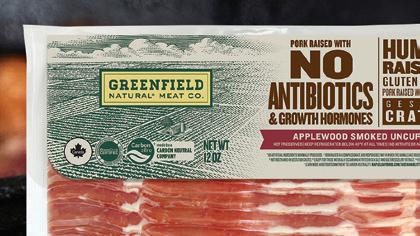












Bacon for All Occasions
FOOD RETAILERS AND BRANDS FIND EVEN MORE USES FOR THIS PERENNIALLY FAVORITE FOOD.
By Lynn Petrak

eople joke about their love of bacon, but it’s true that this is a foodstuff that appeals to consumers on many sensory levels and, as it turns out, on many occasions.
Over the years, public figures have weighed in on the ubiquitousness, usefulness and uniqueness of bacon. “You know, it’s hard to beat bacon at any time of day,” admits actor Nick Offerman. Comedian Jim Gaffigan draws laughs with the observation: “Bacon’s the best. Even the frying of bacon sounds like applause.” Famed chef and
Key Takeaways
Consumers are embracing thicker slices and flavored bacon varieties.
In addition to fresh bacon, other forms of bacon make it easy for consumers to add pork flavor to a wide range of dishes throughout the day.
In addition to carrying more and different bacon SKUs in the meat case and center store aisles, grocers can satisfy bacon-loving shoppers and grow their sales in other ways, including spotlighting premium bacon offerings in the service case.
28 progressivegrocer.com SOLUTIONS Bacon
cookbook author James Beard once said that his ideal last meal would consist of bacon and eggs, and noted, “There are few sights that appeal to me more than the streaks of lean and fat in a good side of bacon, or the lovely round of pinkish meat framed in delicate white fat that is Canadian bacon.”
Today’s food analysts agree that the allure of bacon extends across dayparts and applications. “Eighty percent of people say they like or love bacon,” asserts Patrick Fleming, new business development manager at Midan Marketing, in Chicago. “What else as a country can we agree on? Even when there are down-market conditions, demand stays strong. Bacon complements so many meals, it’s an ingredient, and it always delivers on flavor. I’ve done bacon interviews for a long time, and people will ask, ‘Is the bacon trend over?’ No, it will never be over. There is always innovation, a new daypart, new thickness, new flavor.”
Anne-Marie Roerink, principal and founder of San Antonio-based 210 Analytics LLC, agrees. “Bacon is quite unique in that it does have a strong indulgence role, but at the same time it also plays an important role in many ‘everyday’ meals, from a topping on a salad [to] the classic bacon and egg, or to enhance a burger,” she says.
According to Roerink’s insights, the bacon category has held its own. “Bacon prices spiked well before several of the other proteins started gearing up, but experienced deflation in 2023,” she notes. “This brought consumers back to bacon, resulting in a strong
“Bacon is quite unique in that it does have a strong indulgence role, but at the same time it also plays an important role in many ‘everyday’ meals.”
—Anne-Marie Roerink, 210 Analytics
pound performance in 2023, though the deflationary conditions meant that dollars were down year on year.”
Data from Circana OmniMarket Integrated Fresh, a Chicago-based market research company, affirms that bacon in many forms has remained in shopper baskets. For the 52 weeks ending Jan. 28, sales of fresh packaged bacon reached $5,898,880.631, while sales of deli service bacon hit $5,719,145 and sales of frozen bacon rang up $3,811,214. Salad toppings with bacon came in at $712,500,951, and refrigerated salad toppings/bacon bits reached $904,367 in that time frame.

BEEEEEEEEE BEEEEEEEEE
PROGRESSIVE GROCER March 2024 29

Other market research bears out the enduring appetite for bacon. According to Chicago-based insights firm Mintel, 61% of consumers continue to eat the same amount of bacon as they have before, and nearly half said that they’re interested in trying new products, preparations and flavors.
Bacon makers agree that bacon is a force to be reckoned with as a product and category. “Bacon continues to be such a beloved household staple in the U.S.,” notes Emma Pierce, brand manager for Daily’s Premium Meats, a 130-year-old brand that became part of Merriam, Kan.-based Seaboard Foods in 2005. “It has a very high household penetration.”
According to data cited by Pierce, penetration for bacon exceeds 70% of all households with members between the ages of 25 and 64 and comes in at 76.6% for households with members between the ages of 55 and 64. Even consumers under the age of 25 enjoy bacon, which enjoys 70% household penetration among that crucial demographic.
Add in the statistics on ready-to-cook and heat-and-eat bacon, and you come up with a food that’s versatile and available across several categories. Even the adult beverage and bakery departments have been known to offer items made with bacon.
New Takes on Tradition
As sales figures show, a majority of bacon is purchased in the form of fresh strips derived from pork belly. Many consumers still cook up raw bacon in traditional ways and for classic meals like omelets and BLT sandwiches, but some are experimenting with other recipes as they continue to cook a lot at home in the wake of the pandemic and during an inflationary era.
“It’s not just limited to a few strips of bacon with eggs for breakfast – we are seeing it incorporated in pizzas and even in doughnuts. Bacon can be added to anything savory and to sweet dishes as well,” observes Pierce, who points out that bacon is an easy and effective way to punch up the eating experience. “Being able to add bacon to a recipe gives it more variety.”
As people widen their recipe repertoire – often inspired by posts on social media platforms like TikTok – bacon brands are giving consumers more product options. “When you look at all of the different types of bacon offered in a retail grocery store, there’s a flavor and product for almost everyone,” says Midan’s Fleming, citing the advent of bacon offerings for those with certain dietary interests. “If it’s sugar, curing or whatever else was an obstacle, there’s now a bacon to meet that need.”
There are some trends in the category. As Daily’s expands its reach into the retail sector following a long history in foodservice, the brand finds that consumers are embracing thicker slices and flavored bacon varieties. “We use all-natural hardwood to smoke our product and smoke using slower cycles,” says Pierce. “We use premium ingredients for curing as well.”
One new offering has generated particular buzz among home chefs, she adds. “Most recently, we launched a steak-cut bacon, which has been really very exciting, and we have an ultra-thick bacon in the L-board format, which puts a different spin on bacon, with a

30 progressivegrocer.com SOLUTIONS
Bacon
The Daily's brand of bacon from Seaboard Foods continues to expand into the retail sector with trending products like steak-cut bacon.

meatier cut that’s perfect for people who love bacon,” she explains.
Other bacon brands have fared well with thicker cuts, flavorful smoking techniques and seasonings as shoppers look to do more with fresh bacon. Boar’s Head, based in Sarasota, Fla., offers a Butcher Craft Thick Cut Bacon as part of its collection, while Oscar Mayer, from Kraft Heinz, based in Chicago and Pittsburgh, touts its Naturally Hardwood Smoked Thick Cut Applewood bacon.
“There are a couple of things with thick-sliced or steak-cut bacon,” notes Fleming. “It delivers on more flavor because it’s thicker, and it usually results in less shrinkage, with a better bite. It also holds better if you add it as an ingredient, so it extends across dayparts.”
For its part, the venerable Jimmy Dean brand under the Tyson Foods Inc. umbrella includes Thick Cut Applewood Smoked and Hickory Smoked Premium Bacon varieties. Demand is so strong for these and other bacon products that Springdale, Ark.-based Tyson recently opened a new $355 million production facility in Bowling Green, Ky., to further innovate with new bacon flavors, cuts and products for brands such as Jimmy Dean and the fast-growing Wright label.
“Bacon is a growing category based on consumer demand, both at home and at restaurants, and our expanded production will enable us to lead this growth and drive innovation,” notes Melanie Boulden, Tyson’s group president of prepared foods and chief growth officer.
Retailers have also upped the ante in fresh bacon with their
“Bacon is a growing category based on consumer demand, both at home and at restaurants, and our expanded production will enable us to lead this growth and drive innovation.”
—Melanie Boulden, Tyson Foods EEEEEEEEEEEE. EEEEEEEEEEEE.
private label premium versions that inspire people to use bacon in a host of applications. The Good & Gather portfolio from Minneapolis-based Target includes a No Sugar Uncured Bacon; Monrovia, Calif.-based Trader Joe’s offers an Uncured Dry Rubbed Sliced Bacon; and the Frederik’s by Meijer premium store brand from Grand Rapids, Mich.-based Meijer includes a Naturally Hardwood-Smoked Thick Cut Bacon and a Double Smoked Center Cut Bacon.

PROGRESSIVE GROCER March 2024 31

SOLUTIONS Bacon

In addition to fresh bacon, other forms of bacon make it easy for consumers to add this bit of pork flavor to a wide range of dishes throughout the day. Microwaveable bacon has been on the market for decades now, and it has also expanded to include more premium varieties.
Likewise, bacon pieces and bits in both shelf-stable and refrigerated forms are a go-to ingredient for home cooks. Innovations continue in these segments, too, as evidenced by launches like Jimmy Dean’s Hardwood Smoked, Chopped, Uncooked Premium Bacon, ready to be pan-fried for an accompaniment or ingredient.
The plant-based boom of the past few years has included the introduction of bacon made from plant sources, which can likewise be incorporated into meal and snack occasions. Examples include Veggie Breakfast Meatless Bacon Strips from the MorningStar Farms division of Chicago-based Kellanova, and Smart Bacon from LightLife, of Turners Falls, Mass.
Of course, bacon has long been a star ingredient in foods and remains a go-to addition for products spanning dayparts and categories. Bacon-topped pizzas remain popular, with new items like a Gorgonzola & Bacon with Pear Chutney pizza from Albertsons Cos., based in Boise, Idaho, and a Sharp Cheddar and Uncured bacon stone-fired pizza from Tillamook County Creamery Association, of Tillamook County, Ore.
Egg bites and other heat-and-eat egg-based products are also big right now as high-protein foods remain in demand. The Applegate Farms LLC division of Hormel Foods, in Austin., Minn., has expanded into the breakfast segment with a new line of Applegate Natural Frittata bites, including one variety made with uncured bacon. Kraft Heinz’s Oscar Mayer brand has gotten into this space, too, with Oscar Mayer Scramblers featuring a Bacon and Velveeta option.
Bacon flavor makes its way into foods and beverages in unexpected ways as well. For instance, the Funky Buddha beer company, of Oakland Park, Fla., brews up a Maple Bacon Coffee Porter, while Bentonville, Ark.-based Walmart has carried a bacon peanut brittle product from Goodlettsville, Tenn.-based Brittle Brothers.
Doubling Down on Bacon
In addition to carrying more and different bacon SKUs in the meat case and center store aisles, grocers can satisfy bacon-loving shoppers and grow their sales in other ways, including spotlighting premium bacon offerings in the service case. “This allows people to buy as much or as little as they wish, but also provides a way for even greater in-house innovation and limited- time offers,” points out Roerink. “Additionally, by bringing it into the full-service case, the butcher has an opportunity to upsell by suggesting a bacon-wrapped variety of the meat people are purchasing.”
 Bacon is a star ingredient in many packaged goods, too, like Oscar Mayer's new line of Scramblers.
Bacon is a star ingredient in many packaged goods, too, like Oscar Mayer's new line of Scramblers.
Regarding that point, because bacon has a reputation for making other foods better, retailers often add bacon to their prepared foods and in-store restaurant menu items. For instance, Rochester, N.Y.-based Wegmans Food Markets has offered ready-to-cook bacon-wrapped scallops, while The Giant Co., based in Carlisle, Pa., rolled out bacon-wrapped jalapeños stuffed with cream cheese.
To inspire consumers to think of bacon for more eating experiences, retailers can leverage merchandising tactics. “Bacon also tends to play a star role in cross-merchandising displays aimed at breakfast,” observes Roerink. “While most retailers focus on creating dinner cross-merchandising displays, some will rotate the items by time of day, and America’s love for bacon can certainly result in a nice upsell there.”

Kroger Co., based in Cincinnati, has posted recipes for preparing bacon candy, bacon-wrapped apricots and maple bacon popcorn.
Bacon can be added to many merchandising efforts, in fact. “That’s where retailers have a great opportunity to help ideate on usage occasions and be rewarded with extra sales,” says Roerink, sharing some examples: “A small independent [recently] featured a recipe of cabbage with kale [and bacon], made in the oven or air fryer as a carb-friendly, delicious way to make cabbage. Another put packaged bacon next to ground beef.”
Providing ideas also encompasses how-tos, and many retailers spotlight bacon as an ingredient in their company-developed recipes. Cleveland-based Heinen’s, for instance, has shared tips for making baked maple bacon mini donuts and a BLT dip, while The
Brands, too, give consumers food for thought when it comes to the many ways to prepare and enjoy bacon. “As we start to focus more on our retail presence, we know it’s important to inspire consumers on how to use our products, so we regularly share recipes on our website and social media platforms,” says Pierce. “We also partner with creators, like social media influencers, and challenge them to come up with new recipes.” Daily’s recipes cover a host of sweet and savory applications, including bacon risotto, honey jalapeño glazed bacon, savory bacon jam and a doughnut ice cream sandwich.




PROGRESSIVE GROCER March 2024 33
L.T. L.T. LEARN MORE ABOUT STEAK CUT BACON AT WE PUT BACON FIRST. © Daily’s Meats 2024

Easy Eats
HOW GROCERS CAN TAKE ADVANTAGE OF THE FAST-GROWING RETAIL FOODSERVICE SEGMENT.
By Barbara Sax
combination of higher restaurant prices, cooking fatigue and a quest for convenience is propelling foodservice at supermarkets, making the category one of the fastest-growing and most profitable segments for retailers.
“Foodservice at retail is increasingly replacing quick-service or fast-casual restaurant meals, and convenience plays into that,” notes Rick Stein, VP of fresh foods at Arlington, Va.-based FMI — The Food Industry Association. “Shoppers tell us they plan to eat more meals at home and, according to a September 2023 Harris Poll done for National Family Meals Month, nearly all (90%) strongly or somewhat agree that family meals at home are more economical than dining out.”
As a result, retailers are investing heavily in foodservice. “We’re seeing a renaissance in the foodservice department, with retailers investing in chefs and specialty staff, increasing space allocation, and enhancing variety in an effort to re-energize foodservice departments and make them more top of mind for consumers,” adds Stein.
Key Takeaways
In response to consumer demands for at-home meal convenience, retailers are investing heavily in foodservice, with future investment in the category expected to continue. There’s been an uptick in prepared food purchases centered on lunch.
Supermarkets should also consider building on the success of their signature foodservice items, partnering with local foodservice brands, adding new flavor profiles and on-trend cuisines, and harnessing technology such as interactive kiosks.
34 progressivegrocer.com FRESH FOOD Retail Foodservice Report
Price Chopper offers a New York-style deli experience at its stores.
Patrick Nycz, president of West Lafayette, Ind.-based NewPoint Marketing, sees more grocery stores capitalizing on the opportunity to provide customers with an “easy button” for the evening meal, as well as a way to differentiate themselves from their competitors. In fact, 82% of U.S. retailers are increasing space for fresh-prepared grab-and-go meals, according to Tammy Gonzales, senior marketing manager, deli and prepared entrées at Wayzata, Minn.-based Cargill.
For example, ShopRite, a banner of Keasbey, N.J.-based Wakefern Food Corp., is rolling out its Fresh to Table store-within-a-store concept, which includes a wide selection of readyto-cook, ready-to-heat and ready-to-eat meals, to additional locations. At its 135,000-square-foot Gretna, Neb., store, Hy-Vee recently expanded in-store dining offerings to include a large open Food Hall dining area that offers an expanded breakfast menu, as well as a variety of lunch and dinner options, including Mia Italian, HyChi and Hibachi, Nori Sushi, Market Grille Express, Long Island Deli, and Wahlburgers. The new store, the largest in the West Des Moines, Iowa-based chain to date, also includes a pub with a full sit-down bar, 32 taps and an outdoor patio.
Foodservice is also front and center at H-E-B’s rebranded H-E-B Fresh Bites convenience stores. The San Antonio-based retailer has added more prepared food and convenient meal options to its c-store locations, including its second True Texas Tacos restaurant, which features a salsa bar for spicy sauces and taco-appropriate condiments, and a South Flo Pizza in one of its San Antonio locations.
Tops Markets LLC is another chain expanding space for grab-and-go meals, sides, appetizers, and ready-to-heat and -eat sandwiches. The Williamsville, N.Y.-based chain is revamping seating areas and adding spots for plugging in and recharging devices to encourage customers to eat on the premises, as well as upgrading cooking equipment to convection ovens to allow the chain to expand variety and hot-food offerings.
Future investment in the category is expected to continue. “The sky is the limit for what supermarket retailers can offer regarding meal options for their consumers — the key is understanding the consumer and having a strategic approach to testing out products, meal combinations and pricing,” says Nycz.
Greater Lunch Opportunity
FMI’s report reveals an uptick in prepared food purchases centered on lunch, a trend that suggests there’s significant opportunity to offer new lunch solutions as consumers continue to work at home at least part of the time.
“We are seeing expanded lunch options and menus across categories, especially in urban and higher-income areas,” observes Nycz. “In the Midwest, we see this blossoming at Market District, Mariano’s and several high-end Krogers. Publix, Harris Teeter and H-E-B are all doing a killer job of it in the South.”
“We are exploring more handheld sandwiches and have tested some bowls to accommodate the ‘dashboard dining’ experience,” says Karri Zwirlein, director of bakery, deli and prepared foods at Tops. “We are always exploring new taste profiles, ethnic flavors and upcoming trends.”
Capitalize on Signature Items
According to FMI, supermarkets should also consider building on the success of their signature foodservice items. It’s a smart move, considering that FMI’s research indicates that 40% of shoppers say their
“We’re seeing a renaissance in the foodservice department, with retailers investing in chefs and specialty staff, increasing space allocation, and enhancing variety in an effort to re-energize foodservice departments and make them more top of mind for consumers.”
—Rick Stein, FMI
supermarkets are known for a particular foodservice item.
Dan De La Rosa, group VP of fresh merchandising at The Kroger Co., notes that Kroger brand deli and bakery products have long been basket staples that customers depend on as an affordable centerpiece of a meal, or as a side or finish to a weeknight dinner, family breakfast or game day spread. One example is the Cincinnati-based chain’s Home Chef Fried Chicken, premium double-breaded and hand-dipped, with a signature flavor boasting 18 spices. Kroger recently created new packaging to prolong crispiness.
“We used to think of rotisserie chicken as a high-convenience item, and it still is; however, now we are seeing consumers who want the next level of convenience,” adds Tops’ Zwirlein. “We are seeing a large amount of growth with our picked chicken — rotisserie chicken meat already removed from the bone — so the customer can skip that step and put it directly onto salads and into soups or other recipes.”
Meanwhile, smoked foods have been a success story at Schenectady, N.Y.-based Price Chopper. “We installed smokers in select stores about a decade ago and began smoking pork, brisket, ribs and chicken,” explains Mona Golub, Price Chopper’s VP
Price Chopper locations also feature generously stocked wing bars where consumers can serve themselves.

PROGRESSIVE GROCER March 2024 35
Retail Foodservice Report
of public relations and consumer services. “The output was so well received that we now offer ribs and pulled pork, accompanied by our house-made barbecue sauce, in all our stores.”
Additionally, Price Chopper has expanded its signature fried fish program for Lent, adding ready-to-cook stuffed fillets and casseroles made with crabmeat, as well as fresh store-made shrimp cocktail and seafood salad. According to Golub, the chain has had great success with special limited-time offers and is continually “looking for the next opportunity to meet the moment for our customers.”
Partner with Local Favorites
Supermarkets are increasingly partnering with local foodservice brands to broaden their offerings and cement their positioning as a destination. Nycz notes that Kroger’s partnership with a local fan-favorite chain, Arni’s, is a draw for shoppers. “That’s a competitive advantage, but it depends on knowing your consumer,” he explains. “Putting a Wahlburger’s in Hy-Vee or a Starbucks in a Target represents a calculated strategic move to serve a key demographic.”
Landover, Md.-based Giant Food has partnered with two local favorites in its latest Bethesda, Md., stores. The chain has teamed up with Ledo Pizza in its deli section to offer Ledo’s pastry-thin, square-crust and sweet tomato sauce pizza either as a Take and Bake Ledo Pizza to warm up at home or as a fresh hot-from-the-oven version. Giant has also partnered with
Ben’s Chili Bowl to bring the iconic Washington, D.C., restaurant’s world-famous Chili and Half Smokes to prepared food sections and hot bars in Giant stores throughout D.C., Maryland, Virginia and Delaware.
“Food is a reflection of the communities in which we live,” says Giant Food President Ira Kress. “Unique restaurants like Ledo Pizza and Ben’s Chili Bowl are special, integral fixtures that truly provide a taste of home.”
Meanwhile, over in St. Louis, hometown grocer Schnuck Markets plans to carry a line of pan-Asian grab-and-go entrées and appetizers from local favorite Sister Sister Kitchen.
Stay on Trend
Keeping assortment exciting with new flavor profiles and on-trend cuisines can also drive the category. Cargill’s Gonzales observes that retailers building offerings and assortments aligned with macro food trends are winning with younger customers. “Flavor, variety and food exploration are just as important as in-store experience,” she emphasizes. “Our recent ‘Protein Profile Report’ spotlighted growing demand from consumers for multicultural flavors and fusion. When it comes to global cuisine, Latin and Hispanic foods are leading the way among Millennials and





































































36 progressivegrocer.com
FRESH FOOD
Retailers, manufacturers, wholesalers, brokers, and distributors from around the world – all together, in Houston! BIGGER IN TEXAS, TOO! REGISTER NOW LET’S JUST SAY THAT OPPORTUNITIES WILL BE IDDBA.ORG The premier industry trade show for retail dairy, deli,bakery and foodservice. IDDBA 2023 By The Numbers: • 81% of attendees represented buyers and key decision makers • Over 1,600 retail attendees represented 564 retail companies • 1,977 Exhibit Booths/810 Companies/235 New Companies


Gen Z consumers. In fact, 61% of consumers are interested in Latin cuisine for the variety of flavors its recipes inspire. Consumers are also gravitating toward Latin and Hispanic proteins like barbacoa, al pastor and carnitas.”
Harness Technology
Further, chains are turning to technology to raise their foodservice game. More retailers are installing interactive kiosks to enhance convenience for customers by streamlining the ordering process, through personalized recommendations and easy payment options. This increases satisfaction and order accuracy and reduces wait times.
There are other advantages as well. “Retailers can automatically
“We used to think of rotisserie chicken as a high-convenience item, and it still is; however, now we are seeing consumers who want the next level of convenience.”
—Karri Zwirlein, Tops Markets
adjust deli/foodservice offerings on the menu based on the length of the order line, showing easier, quicker and lower-margin items when there is a long line, and more complex, higher-margin items when there is a shower line,” says Emily McCue Baldeschwiler, product manager, food and beverage at Tampa, Fla.-based Spectrio, a customer engagement solutions provider.
Technology can also make cooking and food prep more efficient. “Robotics and automation in food preparation can increase consistency, speed and safety while reducing labor costs and enhancing food quality,” says Kevin Kroeger, Spectrio’s retail product manager.
















PROGRESSIVE GROCER March 2024 37
Tops is seeing plenty of growth in its picked chicken — rotisserie chicken meat already removed from the bone — that customers can easily add to salads, soups and other recipes.
Food Safety

Verifying Receipt for Food Traceability
TECH-ENABLED, STANDARDS-BASED SOLUTIONS
IMPROVE ACCURACY, ENHANCE EFFICIENCY AND ENSURE COMPLIANCE.
By Frank Yiannas
he food industry now has until January 2026 to comply with the Food Traceability Rule. All of us hope that FDA stays true to its mantra to “educate while it regulates.” With the final rule issued well over a year ago, however, roughly one-third of the time that companies have to prepare has passed. It’s safe to say that most companies are probably not one-third of the way to food traceability compliance.
For those that have not begun to act, the challenge may appear daunting. The rule requires food companies to collect and share key data elements (KDEs) on certain foods and be able to provide those records to FDA, if requested, within 24 hours. The goal is to quickly identify and remove contaminated food from the market, in turn preventing foodborne illnesses.
No Shortcuts to Compliance
Perhaps unsurprisingly, however, shortcuts to compliance are already being considered that could hamper that goal. One that has come to my attention is that some food entities intend to use advanced shipping notices (ASNs)
alone as evidence of a product’s “receipt” throughout the food chain. Indeed, the benefits of ASNs in supply chains are undeniable, but not as the sole means of confirming what was received.
An ASN is generally an electronic notification of a pending delivery sent from a shipper to a receiver, usually before shipment from a facility. While there can be various data elements in an ASN, as long as it’s “accurate” and includes all eight shipping KDEs required by the rule, including the traceability lot code (TLC) and the TLC source or source reference, it meets the requirements of the rule as a shipping record. However, you can’t always trust that what is claimed to be shipped from point A is the same as what’s actually received at point B.
The best way I can explain this is through a common personal anecdote: Recently, I bought a shirt online. When I received the shipping notice, it accurately described what I ordered and said it was on its way. When I received the shirt, however, it was the wrong product.
That was a hassle, to be sure, but at least it wasn’t food involved in an outbreak that could affect the health and well-being of the American public. In that case, not only could a mistake like this have caused illnesses, but it would have been hard
38 progressivegrocer.com GUEST VIEWPOINTS

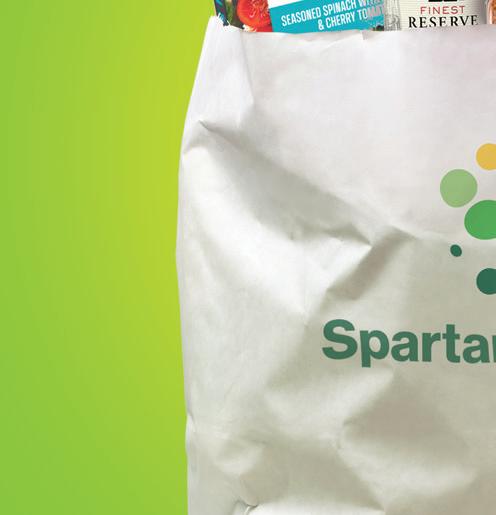


MARCH
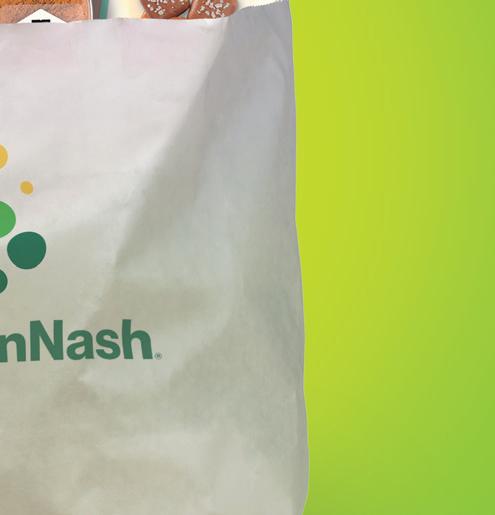
INSIDE JAVA EVOLUTION P.S10
PROMOTING PRIVATE LABEL P.S14
STEPPING UP


SpartanNash takes its private label assortment upscale with the launch of Finest Reserve

THE PULSE OF PRIVATE LABEL
2024
REGIONAL SECTION
SPECIAL

STEPPING UP
SPARTANNASH TAKES ITS PRIVATE LABEL ASSORTMENT UPSCALE WITH THE LAUNCH OF FINEST RESERVE.
By Greg Sleter
Ask Rick Weekley about SpartanNash’s newest private label line, Finest Reserve, and he’s not shy about expressing his excitement.
“I’m starting my 37th year in this industry, and I don’t recall ever having anything that I’ve been as excited about and proud to be a part of,” asserts Weekly, the senior director of creative services and own brands marketing for Grand Rapids, Mich.-based SpartanNash. “It has been a wonderful journey, and we’re just at the beginning of the potential for what we’re doing with Finest Reserve.”
Building off the company’s long history of success with its Our Family private label assortment, Finest Reserve — to steal a line from Chef Emeril Lagasse — kicks it up a notch. Positioned as a premium line, the brand’s initial assortment includes frozen pizza; frozen pasta; sauces, dressings and marinades; premium spices, salts and seasoning blends; and premium chocolates. Wine is also being added to the line, marking the first time that SpartanNash has waded into the wine and spirits category.
This upscale assortment, which is proprietary to SpartanNash and its retailers, could serve as a benchmark for retailers that are looking to evolve their private label assortments. While the history of store-brand products has been to offer consumers lowerpriced alternatives to national brands, retailers are now seeing the opportunity to present premium high-value products that can’t be found at their competitors.
In an interview with Store Brands, Weekly discussed the development of Finest Reserve, the initial response from consumers and the role that this upscale line could play in keeping sales of private label products growing.
S2 Store Brands ● March 2024 ● www.storebrands.com
RETAILER PROFILE: SPARTANNASH
Finest Reserve’s premium assortment includes frozen pizza and pasta, as well as dressings and marinades, spices and seasonings, and chocolates.



A New Alliance: Your Label, Our Paper.


Some things simply go together - for good reason. By delivering quality private label paper products, at the best price, when and where they’re needed, our customers confidently trust us with their label. Just ask and we’ll put it on paper!

•Full range of ultra, premium, FSC® Certifi ed, recycled, and traditional paper grades
• Paper towels, bath tissue, napkins, and facial tissues
• Flexible, custom manufacturing, packaging and displays
• For lower volumes we offer our pre-packaged Azure® Ultra Premium, Daisy®, Delicate Touch®, and Earth One™ store brands.






























www.usalliancepaper.com • 631.254.3030 • info@usalliancepaper.com ©2023 U.S. ALLIANCE PAPER, INC.
RETAILER PROFILE: SPARTANNASH
STORE BRANDS: What were some of the key factors that led to the development of Finest Reserve?
RICK WEEKLY: Turning back the clock a couple of years, SpartanNash was re-energized following a leadership change, and we were making the transformation from traditional wholesale supplier to truly being a customer-centric food solutions provider. The key phrase there is “customer-centric,” especially as we were coming out of the pandemic and consumers were returning to normal. One of the things we explored was our privatebrand program. We did extensive consumer research to understand how the brands were being perceived and if they were meeting the needs of shoppers.
SB: What were some of the key findings from that research?
RW: There were some valuable learnings from our research, one of which was that we had a void in our own brand’s architecture. We had an opening-price-point brand solution and a mainstream brand solution for center store. What was missing was a premium offering. And if you recall during the pandemic, indulgence was still something that people were unwilling to sacrifice, and we knew that was a longer-term trend. That was really the genesis of the process. Our consumer research then went into brand, brand mark creation, naming and then more contact with the consumer to validate the direction. We needed to know the message we intended to have was connecting with consumers.
SB: What led to the selection of the initial products in the Finest Reserve assortment?
RW: This goes back to our customer-centric approach. We started with consumer research to identify what the needs of the premium shopper are. The main thing we found out was they are not willing to sacrifice on quality to get a lower price. And categories such as wine and spirits and chocolate are very much at the top of their list.

I’m starting my 37th year in this industry, and I don’t recall ever having anything that I’ve been as excited about and proud to be a part of. It has been a wonderful journey, and we’re just at the beginning of the potential for what we’re doing with Finest Reserve.
—Rick Weekly, SpartanNash

So we went after the most obvious choices based on that research.
SB: While the line is still in its early stages, has there been an evolution in the time it’s been available?
RW: One of the most exciting parts of my job is every day, I get to walk into the world of Finest Reserve and know that I’m a part of a constantly evolving universe. There is a storytelling aspect to the brand as we work to get the brand top of mind for consumers. With our packaging, for example, we wanted to be very tactile in our approach. We have opportunities to do things such as embossing, textured background or foil sampling. We want this to feel good, taste good and look good when sitting on the kitchen counter at home. Additionally, our storytelling with Finest Reserve is very video-based. We are investing heavily in creative production for digital outlets, be it streaming services, traditional broadcast media and every social application to where we can take the customer on that journey. That story is evolving as the brand continues to grow.
SB: What are the differences in terms of product selection and product development between Finest Reserve and the broader Our Family assortment?
RW: The Our Family brand is celebrating its 120th anniversary, and I believe is one of the oldest private brands in existence in the U.S. So there is a tremendous amount of trust with that brand. When we started talking about a premium brand, we wanted to have the Our Family endorsement be a key element in that journey. This is why we went with Finest Reserve by Our Family. We wanted to have that connection.
When we do item selection and product development, there’s some common criteria for evaluation. It may have to do with flavor profiles, manufacturing standards and so on. While there’s a parallel for the first part of the journey, Finest Reserve then starts branching off. It’s less about the price; the brand is about delivering the experience first. That’s why we went to Italy to find authentic hand-stretched artisan pizzas and other products that offer unique flavor profiles. We also make sure the products are able to deliver a better experience.
SB: Since Finest Reserve offers premium products, how are the features and benefits of the products communicated to consumers?
RW: It goes back to our ability to tell a story and using video and digital tools to drive brand awareness. There is also a journey that includes product packaging, signage on shelf that supports the story and educates shoppers, and use of media to connect with shoppers on various digital platforms. We want to give consumers an emotional connection to the brand.
SB: Early on, what have been some of the big sellers from Finest Reserve?
RW: The chocolates have been huge right out of the gate. We went out with some aggressive price points, introduced digital coupons and did in-store sampling. We want the consumer to feel as if they’re getting a good value as we get them to try this new brand. Our spices have also been steady performers as well. Other products, including the sauces, pizzas and pastas, are just hitting the shelves now. Out of the gate, we have received some favorable responses, and we are focused on keeping that momentum going.
S4 Store Brands ● March 2024 ● www.storebrands.com

RETAILER PROFILE: SPARTANNASH

SB: Will offerings such as Finest Reserve serve to help continue improving consumer perceptions of store-brand products?
RW: I really think so. We need to have a national-brand mindset when we’re presenting a premium product. In the “old days,” the approach with private label products was either we were going to emulate products already on the shelves or take a minimalistic approach. Now, we can’t do that. We know consumers today are more accepting of private brands than ever before, but these products shouldn’t feel like a sacrifice. We did research that indicates things such as packaging perception drive consumer perception regarding the quality that’s inside. As a result, we had to elevate how the product looked on shelf. We want to give the consumer an elevated experience, but also let them know they can save a little money at the same time. I think that’s really important in shaping the future of the private-brand journey.
SB: With the growth seen in private label in recent years, have we reached a point where either retailers or consumers are offering their thoughts on new products they would like to see?
RW: Being a wholesaler and a retailer is a tremendous advantage for SpartanNash. We receive a tremendous amount of data from our stores that are customer-specific to their preferences and desires for product expansion. They’re voting with their wallets. Additionally, social media has been a tremendous asset to us, not just for storytelling, but also receiving feedback from consumers about what they think about our products, and also what they would like to see
Finest Reserve: The Products
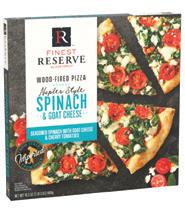
Frozen Pizza
These artisan-crafted pizzas are prepared using a wood-fired, hand-stretched crust and fresh, authentic mozzarella cheese from Italy. The selection consists of Margherita & Basil, Roasted Vegetable, Pepperoni & Spicy Honey, and Spinach & Goat Cheese.
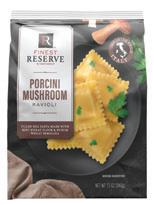
Frozen Pasta
These selections put a twist on a variety of pasta favorites, with all items imported from Italy. The line’s flavors are Ricotta & Spinach Big Tortellini; Eggplant Parmesan Big Girasoli; Porcini Mushroom Ravioli; and Tomato, Mozzarella and Basil Girasoli.
developed. Once you’ve built that relationship [with consumers], they’re not shy. We have also used our social media channels to test packaging concepts to see what our customers respond to the best.
SB: We’re seeing improved consumer perception of private label products. How does this change the product development approach at SpartanNash?
RW: It gives us the confidence to stretch a little bit more than we have previously. We know consumers are now understanding what we are delivering through our private brands. As a result, innovation is now something we embrace rather than fear. In the past, launching a premium private label line would have been a more difficult conversation. Now, this change in perception of private label products has allowed us to remove the internal barriers we may have created for ourselves.
SB: Are there plans for further expansion of Finest Reserve, and, if so, what categories may be added?
RW: The launch has been very successful, and there will be growth and expansion in the future. We’ll be introducing coffee very soon, and we’re going back to Italy for imported dried pastas and pasta sauces. We’re also looking at some specialty condiment areas like specialty mustards and things of that nature. The brand has filled a very important need, not only for the consumer, but also for the retailers that carry our products. Growth is the word at SpartanNash, and that certainly resonates through the Finest Reserve brand. There’s no stopping us now!

Sauces, Dressings & Marinades
A set of eight flavors makes up this assortment of sauces and marinades. They are Sweet Mesquite Molasses, Honey Habanero, Tangy Carolina, Vidalia Onion, Tangy Mustard, Asian Honey, Kentucky Bourbon and Carolina Smokehouse. Salad dressing selections are Vidalia Onion & Peppercorn, Creamy Cucumber Dill, Extra Virgin Italian, and Raspberry Vinaigrette.
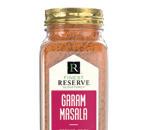

Premium Spices, Salts & Seasoning Blends
Consumers are able to stock their cupboards with this assortment of more than 25 spices, salts and blends. The line’s broad variety includes Garam Masala, Black Truffle Salt, Garlic Powder, Cinnamon, Turmeric, Ground Ginger and Black Peppercorn.
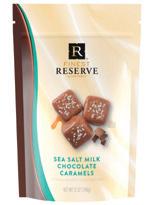
Chocolates
More than a dozen unique selections comprise the Finest Reserve Chocolate assortment. Featured among them are Sea Salt Milk Chocolate Caramels, Mint Chocolate
Chip Cookie Bites, Peanut Butter Chocolate Caramels, Chocolate Raspberry Cremes and Milk Chocolate Coconut Almonds.
S6 Store Brands ● March 2024 ● www.storebrands.com
built

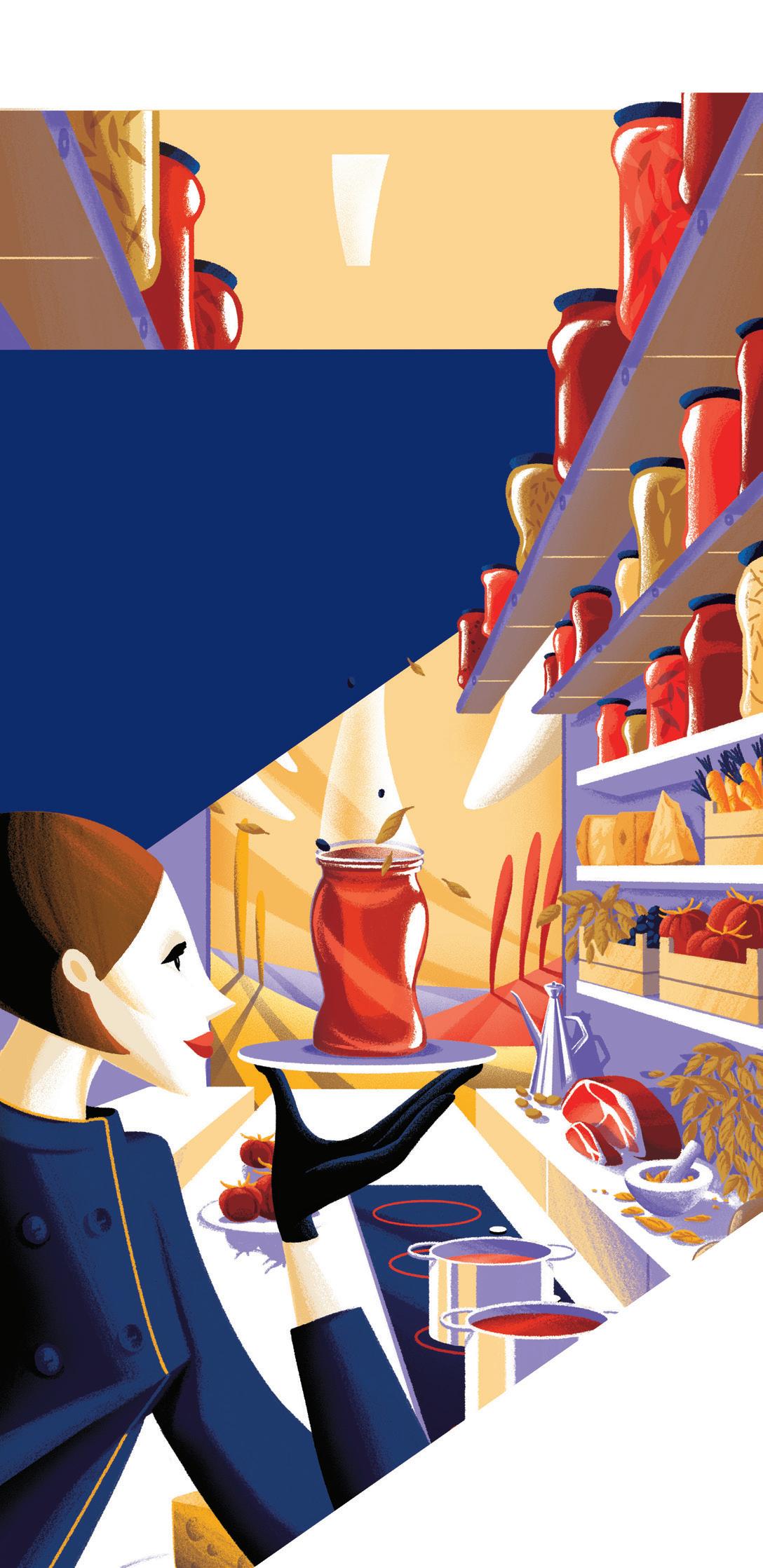
Innovative Products Join the Ready-made Sauce Portfolio

When southern Italy-based La Doria acquired a historic Italian manufacturer of ready-made sauces in 2014, the company became the first Italian manufacturer of ready-made sauces under private label. It also became one of the leading manufacturers in Europe, thanks to two plants located in regions at the heart of Italy’s culinary heritage: Parma in Emilia-Romagna and Campania, in Sarno.
That acquisition has enabled La Doria to invest in research and development initiatives that have led to the development of the kind of high-quality, innovative private sauces today’s consumers are demanding.
“When it comes to sauces, consumers are increasingly looking for high-quality, ready-made products made with safe ingredients of guaranteed origin — products that combine taste with well-being, with clean recipes, without flavorings, preservatives or colorings,” says Diodato Ferraioli, Chief Commercial Officer of La Doria. “Organic food is also a fast-growing segment, thanks in part to the strong presence of private labels, as are vegan and vegetarian offerings.”
Private Label Appeal
Consumers are looking for and finding that quality in private label products.
As Store Brands reported in October 2023, a survey conducted by FMI - The Food Industry Association for its 2023 Power of Private Brands: What’s Ahead for Shoppers and Private Brands report, 69 percent of grocery shoppers said they purchase store brands at least occasionally; 46 percent do so most or all of the time; and 90 percent say they are likely to continue buying private brands even if inflation or the price of groceries decreases.
“Although inflationary pressures may have been the catalyst that prompted consumers to try more private brand products over the past few years, shoppers have clearly come to appreciate the quality and value that store brands offer,” said Doug Baker, vice president of Industry Relations with FMI.
According to Ferraioli, La Doria focuses on quality throughout every step of the production process.
“La Doria attaches great importance to the quality of the products it manufactures, starting with the selection and monitoring of the main suppliers of raw materials, the use of state-of-the-art technology in its production plants, and significant investment in the training of its staff,” Ferraioli explains.
The Experimental Kitchen
La Doria’s state-of-the art kitchen is where the sauces’ journey from being just recipes on paper to retailer’s shelves begins.
“The goal is to develop prototypes that represent the balance between quality and price. Reproducing those prototypes is the most complex phase of production because our sauces and pestos are made with hundreds of ingredients,” explains Sereno Sellitto, Research & Development Managerat La Doria.
The experimental kitchen is where three of La Doria’s newest, most innovative products were developed.
“Vegan food is becoming increasingly popular, and we have received many requests to expand our range of ready-made sauces in this area,” says Sellitto.






Vegan pesto. La Doria already had a vegan pesto made with tofu in its portfolio. “We challenged ourselves to develop a vegan pesto without the soy allergen,” Sellitto says. The result: the new Vegan Green Pesto with Basil.
Vegan Bolognese. “With pea-based vegetable proteins to replace meat, we had fun creating a really interesting product,” Sellitto says, describing the process of creating the new Plant Based Ragu in a glass jar, which he calls “a classic of Italian Sunday cooking, but with a vegan twist.”
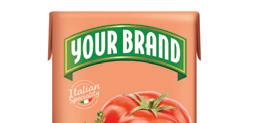
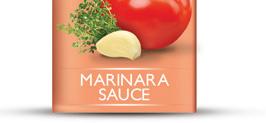






Bricks ofready-made sauces. Economic and environmental concerns led to the development of La Doria’s sauces in brick form — “one of the major innovations in 2024 in terms of product development.” Sellitto says. “Studies carried out by SIG, the company that manufactures the boxes, show that the use of bricks to package the same amount of food emits 63 percent less carbon dioxide than glass.” Some of the most famous recipes in the Italian culinary tradition, such as Bolognese, Arrabbiata and Marinara, are recipes made by La Doria on a Combibloc line that uses aseptic technology in the production process.
“The greatest satisfaction remains the feeling you get walking through supermarkets and coming across one of your products and thinking, ‘I made that!’” Sellitto concludes.
ADVERTORIAL FOR MORE INFORMATION,VISIT www.gruppoladoria.it OR EMAIL commerciale.estero@gruppoladoria.it.

JAVA EVOLUTION
AFFECTED BY PRICING AND FOCUSED ON HEALTH, CONSUMERS ARE CHANGING THEIR COFFEE DRINKING HABITS.
By Greg Sleter
Coffee remains a popular drink of choice for many Americans, but the style of java being consumed on a daily basis continues to evolve, which is opening up new opportunities for private label growth.
Figures from Chicago-based market research firm Circana show that overall dollar sales for coffee for the 52 weeks ended Jan. 28, were up a modest 1.4% to more than $12.4 billion. Private label coffee sales were up 1.8% over that same period, with sales of $2.2 billion. However, private label unit sales were down 1.4% as compared with national brands, which saw sales off by 1%.
The largest segment in coffee — single-cup — also saw private label make gains, with dollar sales up 2.4% compared with nationalbrand products that were flat year over year. Unit sales for private label products were down 1.6%, with national brands down 2.1%.
Noteworthy in the single-cup segment is the difference in price
per unit. Circana’s figures show national brands priced at $12.51 per unit, while private label products come in nearly $4 lower, at $8.67 per unit.
A deeper dive into the statistics from Circana shows robust growth for private label products brewing in several segments of the coffee industry. Dollar sales of store-brand instant coffee were up 18.4% for the 52-week period, which gave unit sales a boost of 5.8%. By comparison, national-brand dollar sales of instant coffee were up 5.3%, with unit sales up 1.1%
While private label products made gains in key coffee segments related to home brewing, momentum was missing with ready-to-drink products. Dollar sales in the cappuccino/iced coffee segment were down 39.3%, and cold-brew dollar sales were down 4.7%. Private label products account for a small percentage of overall sales in each segment.
While the Circana figures offer insight into the overall coffee category as well as the growing impact that private label offerings are having, the consumption habits of consumers continue to evolve.
Christine Dang, category manager at Los Angeles-based e-grocer Thrive Market, says that although coffee category sales have been flat, there continues to be an evolution in the style of the popular beverage that consumers are looking to drink on a daily basis. Most notable is the desire for many to seek out products with lower levels of caffeine.
“We’re seeing a shift toward other things such as tea matcha, where you have caffeine, but it is lessened,” she observes. “We are also seeing consumers shift to coffee that offers functional ingredients as well.”
Solange Ackrill, VP marketing and corporate strategy for Etobicoke, Ontario-based Club Coffee, notes that the research from
S10 Store Brands ● March 2024 ● www.storebrands.com

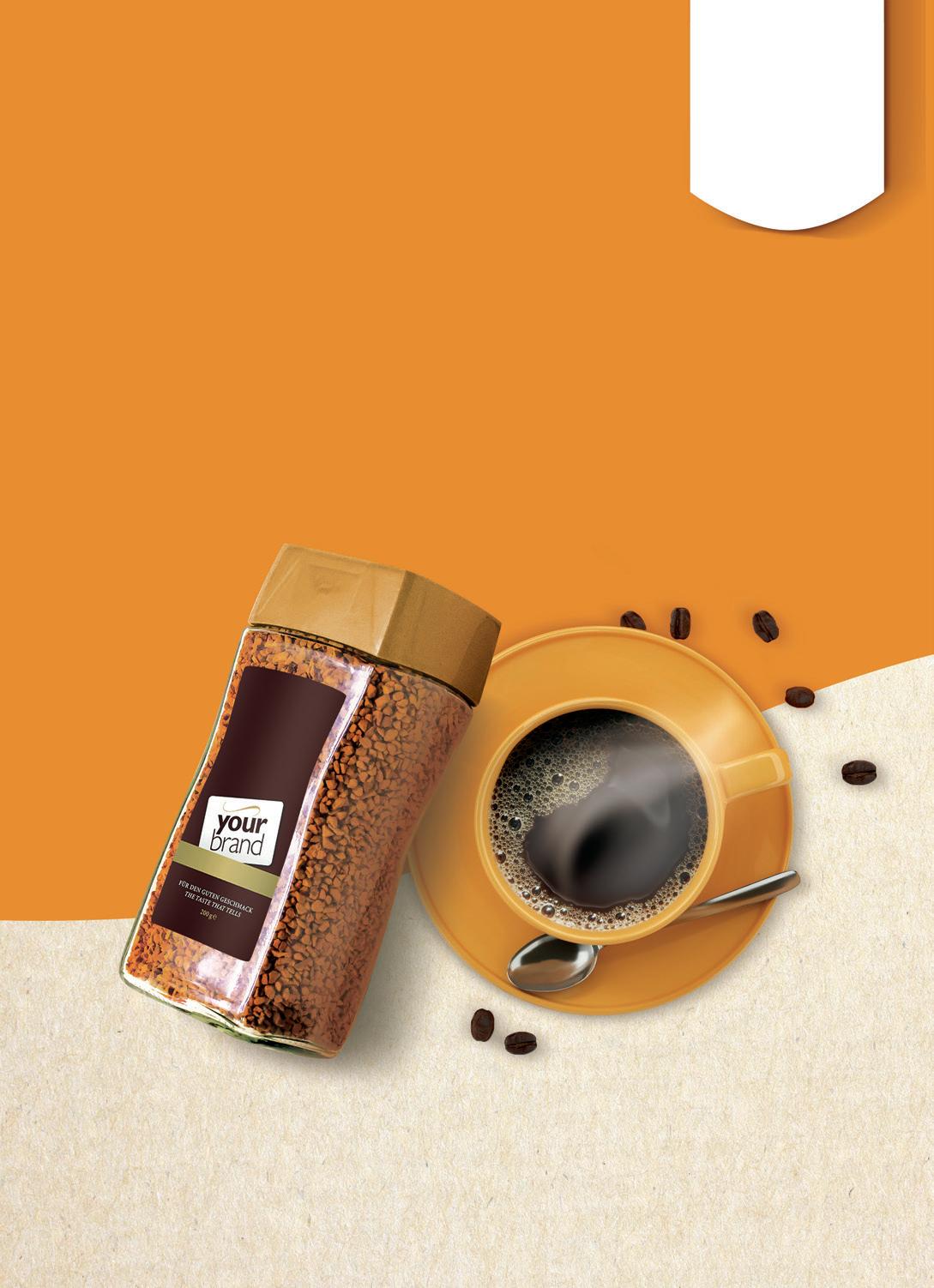


Your leading partner for retail, food industry and vending worldwide. We are leading PL supplier for a wide range of soluble coffee solutions, liquid coffee and individual taste. DEUTSCHE EXTRAKT KAFFEE GMBH · CAFEASTRAßE 1 · D-21107 HAMBURG · +49 (0) 40 753040 · SALES@DEK.DE · WWW.DEK.COM ☎ MEET US IN AMSTERDAM – PLMA 2024 May 28 – 29 Food section, Hall 01 Europe Complex TAKE A LOOK AT OUR VIRTUAL SHOWROOM Our Soluble Coffee Products
COFFEE
leading coffee industry trade groups such as the New York-based National Coffee Association show past-day consumption numbers in the United States above 60%, making coffee the top beverage consumed daily. However, she acknowledges that despite those strong figures, consumer habits related to coffee are changing.
“While consumption is steady, where, how and what consumers are drinking is evolving,” she says. “We’re seeing growth in colder for younger entrants into the category, more at home due to a hybrid workforce and a shift to value and convenience.”
Experiments in Coffee
Multifunctionality is a growing trend within coffee as more consumers are seeking coffee that provides more than just a morning boost, but also ingredients such as mushrooms and adaptogens that help the body manage stress and restore balance after a stressful situation.
According to Dang, the growing popularity of coffee containing these ingredients is the result of consumers doing more research as they seek healthier alternatives. Also, companies and brands have expanded their marketing efforts.

“I think it’s really all about proper education,” she explains. “We have had these types of products for a while, but it was very niche. Now, with more education and marketing of these products, the consumer is understanding the benefits of these products and exactly what they do.”
Ackrill notes that consumers are experimenting with various methods in both hot and cold coffee and with additives such as nondairy nut-based whiteners like oak milk, and functional additives that include vitamin or protein powders.
Additionally, instant coffee, which traditionally is viewed as a choice for older consumers, has gained popularity with younger consumer groups. Driving this growth is the social media trend of “whipped coffee” that uses instant coffee. While this trend started during the pandemic, younger consumers have continued it post-pandemic, she says.

Seeking Value and Sustainability
As with every consumable category in recent years, economics have had an impact on consumer choices. As a result, Dang says that Thrive Market has seen a shift in its customer purchase habits to private label products as shoppers have sought to save money and find a better value. That growing desire for better value has led Thrive to launch value pack sizes.
“That’s been helpful to alleviate costs,” Dang notes of the value pack additions. “It’s more of an upfront cost, but our customers realized the savings over time. Our members are pretty savvy in terms of price savings.”
Club Coffee’s Ackrill says that inflation has affected the coffee choices of consumers, with private label brands representing everyday value and becoming more popular with shoppers.
“Higher prices overall have impacted what and where consumers are buying their coffee,” she observes. “For example, if a value brand raised its price and that price was closer to the price of a premium brand, consumers may choose to buy the premium brand instead of the value brand. Additionally, consumers are also shifting to alternate channels, from traditional grocery to clubs and ecommerce channels, if there is more choice and value.”
As with other retailers, Thrive has also seen private label coffee sales grow. While price/value is a key factor in consumers choosing the retailer’s own-brand coffee over national brands, sustainability is also playing a significant role in the decisionmaking process of shoppers.
Dang points out that Thrive’s coffee assortment has long been regeneratively grown, a process that includes several components such as crop biodiversity, minimizing water usage and ensuring farmers are paid a premium for the coffee beans they harvest.
“While regenerative growing has long been a big component of our coffee, we never educated our members about it,” she observes. “But they are starting to understand it more, so that adds to our sustainability message, along with the quality of ingredients we use.”
S12 Store Brands ● March 2024 ● www.storebrands.com
Wegmans offers a robust assortment of private label coffee varieties in its stores.
Thrive Market has noted a growing consumer trend toward multifunctionality in coffee, as illustrated by brands such as Four Sigmatic.

Everything we do is a root in the rich soil that takes strong relationships, knowledge, and timing to do it right. And it all starts with a single seed.
Seneca’s high quality produce is sourced from over 1,400 American farms—family farmers we have done business with for many years, and in some cases generations. Our motto of Farm Fresh Goodness Made Great echoes throughout our fundamental beliefs, which have been key to our success since 1949.
Next year, Seneca Foods will be celebrating 75 years in business. We have spent these years working hard to become one of the most highly integrated fruit and vegetable processing companies in the US. We manage many—and in some cases all—aspects of production, to provide families with a wide range of nutritious fruit and vegetable products that are safe, satisfying and sustainable.
We do it together, the same way we have for over seven decades. Because our roots run deep.

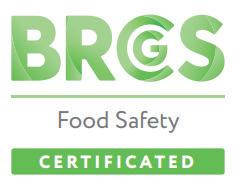

P
f AMERICAN
FARMERS 99%
PROMOTING PRIVATE LABEL
INSIGHTS INTO HOW RETAILERS CAN CONTINUE EXPANDING THEIR OWN-BRAND ADVERTISING EFFORTS.
By Greg Sleter

Retailers in recent years have invested time and money to develop and expand private label assortments across a host of categories. Accordingly, as inflation in recent years led many consumers to alter their shopping habits and turn to the money-saving options store-brand products offer, retailers have taken steps to raise the profile of their proprietary brands.
In 2023, The Kroger Co., Target Corp. and Whole Foods Market, among others, led the charge to raise the profile of their respective store brands. Following a playbook long used by national brand CPGs, retailers focused on the quality and value of their assortments, and often used themes such as happy families cooking at home to convey the vital role that their products play in the daily lives of consumers.
Will the trend continue? Will we see retailers expand their efforts to promote their store brands to consumers? Katie Kelly-Landberg, VP of business and brand leadership at Minneapolis-based advertising company Periscope/Favorite Child, shares her insights on the advertising efforts of retailers as it pertains to their ownbrand products, and what we may see from retailers continuing this effort throughout 2024.
STORE BRANDS: When we see retailers more aggressively advertising their private label products, are we seeing a change in mindset, or are they merely reacting to the needs of their shoppers?
KATIE KELLY-LANDBERG: With the economy being shaky over the years since COVID and shoppers’ habits changing, private label has continued to grow and earn trust with consumers. As a result, businesses are definitely focused on bringing more consumers to their private label products. The other key is personalization. As a mom of teenagers, what am I interested in from [a retailer’s] private label assortment. What am I looking for in clothes, snacks and food? Social media is a huge support of that. It’s fascinating to watch the work retailers have done with influencers, or even getting their customers to be supporters of the brands.
SB: We expect to see more retail advertising focus on private label products. What would you recommend as the best tactics they should use to communicate with shoppers?
KKL: I think it falls in line with traditional marketing. It’s important to really figure out who the consumer is and how this
S14 Store Brands ● March 2024 ● www.storebrands.com MARKETING



ACTIONABLE INSIGHTS & CONNECTIONS POWERING BUSINESS GROWTH
EnsembleIQ is the premier resource of actionable insights and connections powering business growth throughout the path to purchase. We help retail, technology, consumer goods, healthcare and hospitality professionals make informed decisions and gain a competitive advantage.
EnsembleIQ delivers the most trusted business intelligence from leading industry experts, creative marketing solutions and impactful event experiences that connect best-in-class suppliers and service providers with our vibrant business-building communities.



















ENSEMBLEIQ.COM
product or brand is going to add value to their life. The next step is to figure out where to meet them in their day-to-day interaction with the brand. That could be retail media networks. It could also be pop-up ads that appear on their phone when consumers are searching groceries or recipes. It’s always important to keep in mind that [consumers] need to hear how products are going to add value to their lives.
SB: Is there any difference between how retailers should be promoting their brands on the shelves versus the brand that’s on the front of the store?
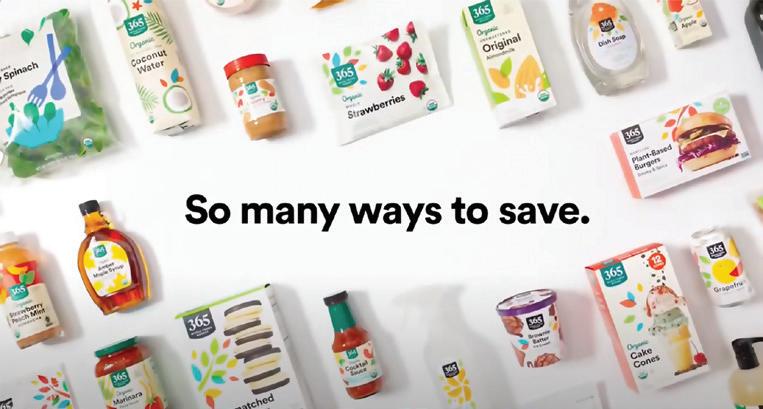
KKL: What we’ve witnessed over the years is how well retailers have defined their own brands and won over the trust of the consumer. So, for example, Cat & Jack from Target was one of my favorite brands when my kids were younger, because there was always an element of surprise. My kids liked Cat & Jack, and I loved the value and the durability of products in the line. And my husband would go to Target to get products from Goodfellow. When those own brands build quality and have a good reputation that they’re able to stand on their own and start talking about themselves as a living, breathing thing. And so you’ve seen in the marketplace, some retailers have done it amazingly well, and some are just beginning to get accomplished in their journey.
SB: What are the biggest challenges for retailers as they promote their private label products?
KKL: It’s an interesting question, given the differences in retailers. ALDI’s assortment is 90% own brands, but when you look at Target or Walmart, they also have a broad selection of national brands, which help pay for some of their advertising. But when, as a retailer, you’re promoting your own brands, that money is
coming from inside your pockets. It’s a fine line for retailers to walk. It’s also quite interesting when you look at Trader Joe’s and what they’re doing to promote their product, which are all store brands. Promoting not just the product, but the overall culture of the company, can build loyalty with consumers.
SB: What should retailers keep in mind as they look for new opportunities to promote their private label products?
KKL: It’s important to understand that the world of own brands is becoming much more sophisticated. We hear a lot of people say they trust own brands now and that they’re willing to try them. And I think own brands are so much smarter now. They’re really defining and finding that white space with their shoppers that not only are winning with those who are already loyal, but they’re building awareness for people who may shop the store down the street. They are offering products that are good for their shoppers, and they are also keeping a close eye on the trends as well.










It’s important to really figure out who the consumer is and how this product or brand is going to add value to their life. The next step is to figure out where to meet them in their day-to-day interaction with the brand.

—Katie Kelly-Landberg, Periscope/Favorite Child

S16 Store Brands ● March 2024 ● www.storebrands.com
MARKETING
Whole Foods Market, seen here highlighting its 365 private label, was one of several retailers to feature store-branded products in consumer-direct advertising campaigns.
to trace and fi x the error during an outbreak, when speed and accuracy count. In a nutshell, a notice of what’s claimed to be shipped doesn’t always reflect what’s received. And while the goal is to make the information in ASNs 100% accurate, industry studies show we’re not there yet, and certainly not with food.
Shipping and Receiving Are Distinct Events
That’s why, when the Food Traceability Rule was drafted, shipping and receiving were identified as separate critical tracking events (CTEs) for which traceability data must be collected. The common thread is the TLC, which is used to accurately confirm shipment and receipt and link to other required data.
Not only could a sole reliance on ASNs fail to ensure accurate data about what was received, but when unverified, it also represents a potential weak link in any traceability plan, risking a company’s compliance with the Food Traceability Rule or, worse yet, incorrect assumptions during an outbreak investigation.
Instead of relying solely on ASNs, companies should adopt a “trust but verify” mindset. That involves developing and adhering to verification protocols that confirm what was received is indeed accurate when compared with an ASN.
In today’s food system, many entities will likely leverage some form of technology to do just that. Because of concerns about the cost of labor, some may choose to conduct verification activities of what is received at the pallet level. However, for maximum confidence and accuracy, verification could occur at the case level.
Tech-Enabled Solutions for Collecting and Sharing Food Traceability Data
There are different ways to verify what was received, which I’ll refer to as high-labor, low-labor and no-labor compliance models. They all leverage technology, to some degree, to capture KDEs and TLCs at each CTE in a company’s supply chain system.
In higher-labor models, companies employ industry consensus standards, such as GS1’s GLNs, GTINs, SSCCs and GS1-128s that contain KDEs embedded in 1D or 2D barcode labels. Workers with hand-held devices can scan the barcode labels on cases or pallets, or the cases/pallets are passed by stationary scanners. For many, this is likely to be the easiest path to food traceability compliance. Further, even though most barcode scanners work reliably, they require line-of-sight access to each barcode, and labor to scan or position products to be scanned. Also, human interventions and scans are always susceptible to error.
In a lower-labor model, companies use higher-tech data carriers (also programmed to capture GS1 standards that contain required KDEs), such as radio frequency identification (RFID) labels and fi xed RFID scanners in their facilities, to automatically capture traceability data as cases and/or pallets or other shipping containers move through or are received. Some companies already use RFID “tunnels” or other tracking infrastructure. While this approach can enhance accuracy and require less labor, it can be costly due to the type of scanners and labels needed. When those RFID scanners are of the hand-held, manual and lower-cost variety, there can be added labor costs and still the potential for human error.
As technology evolves, a no-labor, low-cost model is emerging that uses ambient Internet of Things (IoT) technology to communicate automatically and constantly with Bluetooth


You can’t always trust that what is claimed to be shipped from point A is the same as what’s actually received at point B.
devices. When so-called ambient IoT pixels (lowcost sensors the size of a postage stamp) are programmed with traceability data in conformance with GS1 standards, and affixed to shipping cases, they transmit information without the need for manual scanning. Also, since Bluetooth devices are everywhere, the infrastructure needed for this approach is significantly less costly. In addition, IoT pixels can do more, like collect data about the location of a food and the environmental conditions it has been exposed to, such as moisture and temperature.
Any of these models will work. Thanks to GS1 standards, today’s traceability technology can better automate and streamline the food chain while ensuring that companies comply with planning, data-collecting and reporting requirements. Most important, they eliminate any gap in the compliance chain caused by a naive reliance on ASNs alone to perform a tracking function they weren’t designed for.
Adding Value Beyond FSMA Compliance
As companies apply technology to their food traceability requirements, they can use it for more than just food safety compliance, like creating a modernized, more resilient 21st-century supply chain. Whether high-, low- or no-labor tracking is deemed preferable, some investment will be required. If food companies use these compliance investments to, for example, improve supply chain performance, reduce food waste, enhance freshness or lower their carbon footprint, they’ll see far greater returns.
First things first, however: Food companies need to recognize that food traceability compliance is closer than they think. The FDA’s food traceability requirements were created purposefully, and a shipping notice was never intended to be equivalent to a receiving event. How companies decide to confirm receipt of goods — via manual or automated scanning, or ambient IoT — is up to them. But there can’t be any shortcuts when it comes to food safety.








Frank Yiannas is the former FDA deputy commissioner of food policy and response, and has served as strategic advisor to Wiliot, an ambient IoT solution provider with offi ces in Caesarea, Israel, and in the U.S. cities of San Diego; Bentonville, Ark.; and Irving, Texas.

PROGRESSIVE GROCER March 2024 39

KAIVAC® CLEANING SYSTEMS FOR GROCERY STORES


RESTROOMS
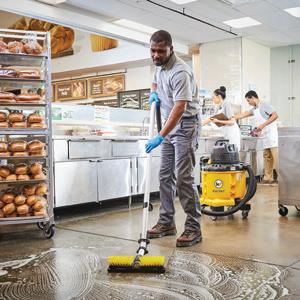
SPECIALTY AREAS
SCAN FOR MORE INFORMATION

Clean is Good for Business.
Grocery store cleaning presents unique challenges. Keeping a clean, safe and inviting store is incredibly demanding, but absolutely necessary. From customer impressions to food safety, cleanliness in the grocery business is a key component in customer loyalty, reputation and profitability.
At Kaivac, we create and test science-based, worker-friendly solutions that measurably deliver maximum results with minimum effort while remaining cost-effective all while protecting the worker.
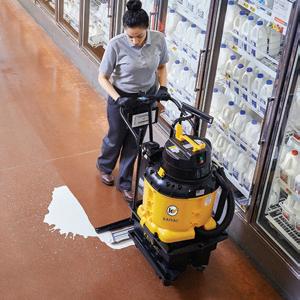
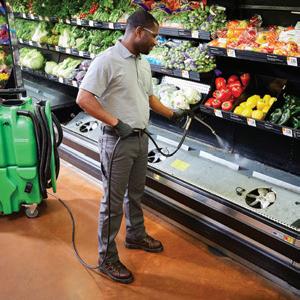
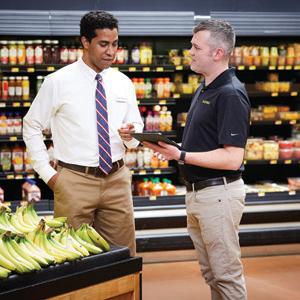
Call Kaivac at 800-287-1136 or visit us at kaivac.com to learn more.
REFRIGERATION
FLOORS CUSTOM SOLUTIONS

Going Behind the ROI of Sustainability
GROCERS
KNOW SUSTAINABILITY
INITIATIVES ARE CRUCIAL TO THEIR BUSINESSES, BUT HOW CAN THEY PROVE THE RETURN ON INVESTMENT OF SUCH PROGRAMS? By
Emily Crowe

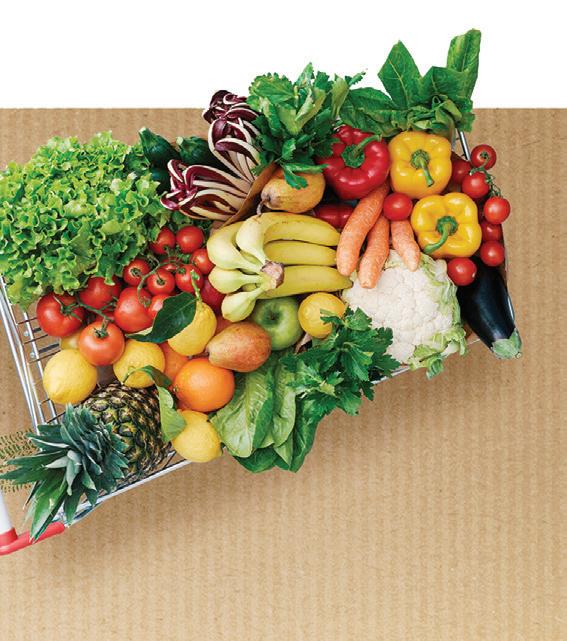

ustainability has become a driving force for good in the grocery industry in recent years. Initiatives surrounding food waste diversion, carbon footprint, emissions reduction, and more have proliferated, and the need to prove the return on investment (ROI) of these programs is becoming increasingly pressing.
Doing so, however, has been a perennial challenge for food retailers.
According to Christina Lampert, director of growth and innovation at Brooklyn, N.Y.-based sustainable food-rating company HowGood, the major retailers she works with have identifi ed an inability to convey streamlined communication about efforts being made as one of the main challenges of proving the ROI of sustainability. Different certifi cations, non-standardized agricultural practices and other claims are well and good, but they can often leave grocers in the lurch.
“If you think about a retailer who is procuring so many different types of CPG products, for example, all of these brands are talking about their own different sustainability initiatives, and it’s then up to the retailer to explain it to the shopper,” Lampert explains. “And what retailers are really struggling with is the fact that there’s no way to standardize all of that into one simple, digestible message for the shopper.”
Lampert also notes that many retailers have extremely low-carbon products on their shelves, such as seaweed snacks or pumpkin seeds, but they don’t necessarily qualify for a standard or certification. “There’s a huge opportunity there, but
it’s just a challenge to identify what’s what in a unified manner,” she observes.
Measurement is definitely a challenge, agrees Corey Rochkin, principal at New York-based management consulting firm Oliver Wyman, especially since most of
Key Takeaways
Gathering data on in-store sustainability initiatives can inform category buyers’ purchasing decisions.
As the regulatory environment and investor expectations evolve, retailers’ ability to measure emissions could have a direct impact on their fi nancing costs.
Programs focusing on waste reduction and energy efficiency are other avenues where retailers can generally fi nd strong returns.

42 progressivegrocer.com
FEATURE Environmental, Social and Corporate Governance




















































































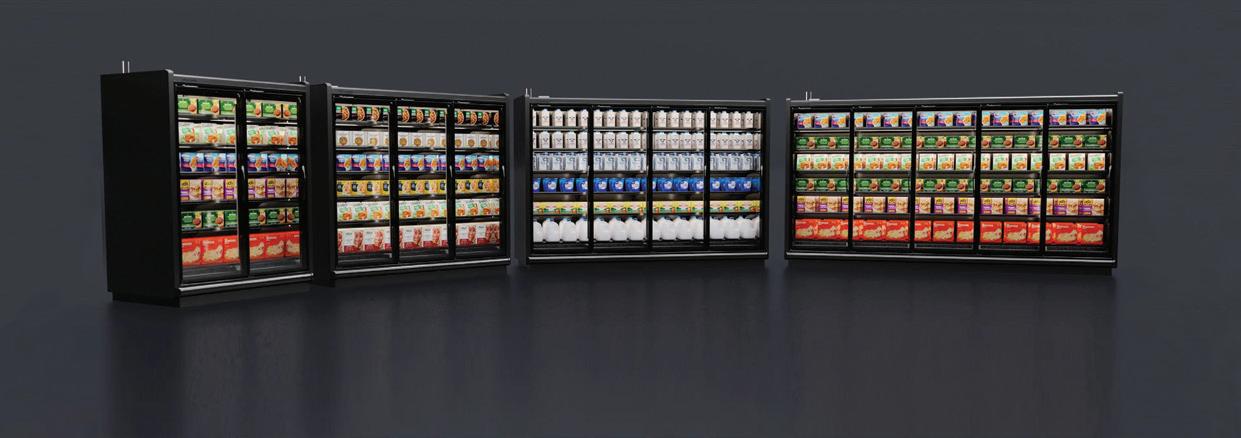
The Impact of Innovation: How New Merchandisers and Low GWP Solutions Help Retailers Succeed
Do you understand how the new Environmental Protection Agency (EPA) rules related to low global warming potential (GWP) refrigerants will impact your store? And are you prepared to comply?
Those are questions that every grocery retailer should be considering, with a particular focus on how those rules will affect merchandisers in their stores.

“The EPA’s Technology Transition rule mandates that all new equipment will have to meet specific Subsector GWP limits,” says Mike Schafer, VP Core & Distributed Products for Hussmann.
“As it relates to retail food refrigeration, the EPA defined the subsectors as Stand Alone/Self-Contained Equipment, Remote Condensing Units and Supermarket Systems.
”While the new GWP limits will give retailers a narrower list of refrigerant options, Schafer expects them to spur innovation too.
New Products = Better Energy Outcomes
Hussmann’s new Insight Reach-in merchandiser (at top) — compatible with R-744 (CO2) and the proposed SNAP 26 refrigerants — is an example of how the company achieves bestin-class innovations in merchandising while meeting energy efficiency needs. The unit’s no-heat, glass door maximizes the viewable product area, offers increased pack-out and lowers energy consumption, too.
“Even with a great pack-out, the new merchandiser uses 25 percent less energy as compared to those with conventional heated doors and reduces in service costs due to the improved reliability,” Schafer says, noting that those benefits “will have a very favorable impact of reducing total cost of ownership.”
With a GWP of 1, CO2 is an excellent option for remote merchandisers such as the Insight Reach-in — an area expected to
see continued innovation and growth in the coming years.
Another low GWP merchandising solution is R-290 (propane) self-contained cases. Hussmann’s SIM (Specialty Island Merchandiser) uses less than 10 kWh per day and plugs into a standard outlet. Its design provides retailers exceptional flexibility for displaying products throughout the store and comes in a range of sizes.
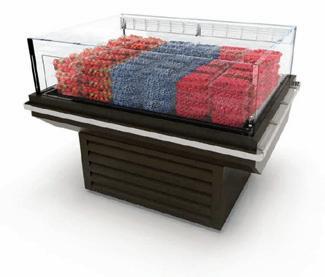
Other expected developments include the design of A2L compatible merchandisers.
Preparing for the New EPA Requirements
These new EPA rules can be complicated to follow. From entire store Low GWP refrigeration systems to compliant merchandising cases, Hussmann partners with its customers to find the most energy efficient solutions for each retailer.
For a quick recap, here are the compliance deadlines for each type:
Earlier this year, Hussmann launched its comprehensive Evolve Technologies portfolio—including core and specialty merchandisers; refrigeration systems including Transcritical CO2; and products featuring natural solutions with CO2 and R-290, as well as low GWP A2L’s.
TO LEARN HOW HUSSMANN CAN HELP YOUR STORE COMPLY WITH NEW EPA REQUIREMENTS AND SAVE ENERGY, VISIT Hussmann.com OR CONTACT YOUR HUSSMANN SALES REPRESENTATIVE. ADVERTORIAL Retail Food Refrigeration EquipmentRegulation Effective Date Stand-alone Units (self-contained equipment) January 1, 2025 Remote Condensing Units January 1, 2026 Supermarket Systems January 1, 2027


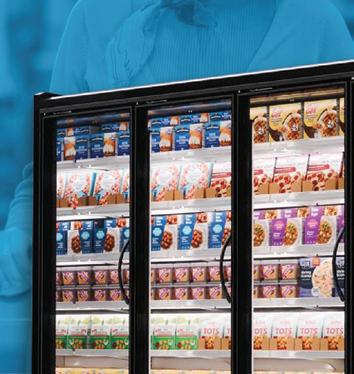





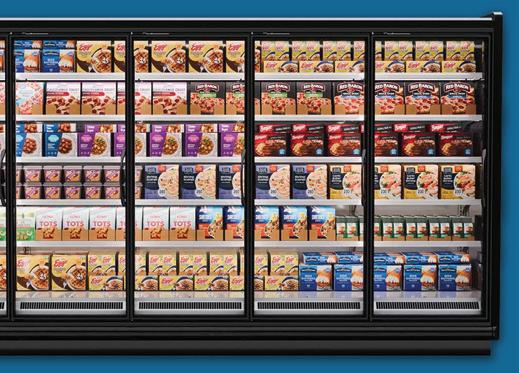


> > > >
Environmental, Social and Corporate Governance

the emissions tied to a grocer are scope 3 emissions, which are generated by other players in the value chain through the production, delivery and use of the products the grocer sells. This means grocers often must rely on their suppliers and partners to measure and reduce these emissions.
Overcoming the Challenges Through Data
While challenges persist, Lampert says that it’s important to look at different types of data in an effort to inform sustainability initiatives. NYU’s Stern Center for Sustainable Business, for example, found that sustainability-marketed products grew twice as fast as conventionally marketed products, and in retail, sustainability-marketed products enjoyed a price premium of 28 versus their conventionally marketed branded counterparts. Additionally, products marketed as sustainable were less susceptible to price sensitivity.
“From this perspective, it’s in the retailer’s best interest, strictly from an ROI perspective, to actually enable their category buyers with this information to understand what they can market as sustainable and therefore retrieve these business benefits associated with that, whether it’s long-term or short-term margin,” Lampert says.
Gathering data on in-store sustainability initiatives can also be a good way to start the journey forward with category buyers. Lampert believes having hard data from pilot programs can help retailers make more informed decisions and help buyers know what’s best for their individual businesses. “I think it’s exciting for everyone once that data is put in place to kind of inform some of those future buying decisions,” she notes.
Andre Patenaude, director of solution strategy at St. Louis-based climate solutions provider Copeland, agrees that data can be crucial to making truly effective sustainability decisions, especially
since higher ESG scores can often be correlated with companies’ receiving higher average annual returns.
“Even if this is not always the case in the supermarket sector, many companies leverage this data as a competitive differentiator,” Patenaude explains.
Initiatives That Help Drive Financial ROI
Banking on the fact that the majority of a retailer’s greenhouse-gas environmental impact comes from scope 3 emissions, which are largely dependent on all of the products that their buyers choose to source, Lampert believes this is exactly where the opportunity for financial ROI lies. Since this subset of emissions arises from operations across the value chain, companies must work together with suppliers, farmers and others to make a true difference.
“Companies with formalized ESG programs that can demonstrate progress along their sustainability journeys are well positioned in the retail marketplace.”
—Andre Patenaude, Copeland
46 progressivegrocer.com FEATURE
Lowering carbon emissions has become a must for grocers of all shapes and sizes.
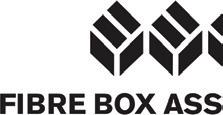





















Corrugated boxes make the world go ‘round in a truly circular motion. The industry’s long-standing commitment to sustainability adds up to an incredible 50% per unit reduction in the greenhouse gas emissions for an average corrugated box from 2006 – 2020, and we’re still improving. Boxes transport everything with the right combination of new, fresh fibers and recycled fibers to maximize reuse and enable circularity. New fibers come from renewable, sustainably managed trees that take carbon dioxide out of the atmosphere – tackling a major threat to our climate. And, more than 90% of corrugated boxes are successfully recycled.
If you’re thinking circular, you’re thinking corrugated.
Learn more about the renewability, recyclability and responsibility of boxes at: https://www.fibrebox.org/life-cycle-assessments.



Planting for the Future:
Demand for plant-based foods is soaring, on pace to expand at a compound annual growth rate of 12.2% between 2023 and 2033, according to Future Market Insights. Diets focused on plant-based foods have been shown to possess health benefits with a lessened impact on the environment.
The plant-based industry is still evolving with tremendous potential for grocers. Here, Progressive Grocer spoke to Julie Emmett, vice president, marketplace development, for the Plant Based Food Association to understand the importance of selling products with the Certified Plant Based seal.
High Trust for Certifications
80% trust certifications
74% trust a product with a CERTIFIED SEAL more than a seal that isn’t certified
High Awareness of Certifications
98% of participants are aware of certifications
79% believe it is either very important or extremely important for food products to be labeled with certifications
PG: The term "plant-based" is growing in popularity on food labels and menus. However, there doesn’t seem to be a widely understood idea of precisely what the term means. Is there an established definition of a food product or meal that can be marketed as “plant-based?”
Julie Emmett: The Plant Based Foods Association defined the term in 2018 through the Certified Plant Based seal. It’s simple: Plant-based foods are foods made from plants that do not contain any animal products. Foods qualifying for Certified Plant Based are made from various plants (including vegetables, fruits, whole grains, nuts, seeds, peas, beans, pulses), fungi, and/or algae. While a small percentage of a product’s ingredients can be composed of key elements like flavors and emulsifiers, plant-based means zero animal-derived ingredients.
PG: What is the Certified Plant Based label and what does it signify for consumers?
JE: The Certified Plant Based seal is a visual indicator that products are made only from plants, with no animal-derived ingredients. It makes it easier for shoppers to trust that the product meets the plant-based standard, no matter their dietary preference.
PG: How can the Certified Plant Based label benefit brands and products in the marketplace and also help retailers?
JE: Ensuring plant-based products are certified can help brands stand out and appeal to a wide range of shoppers. It can also enhance customer trust and brand loyalty, communicate a product’s sustainability benefits, and align with retailer and consumer demand for ingredient transparency. By providing customers with a wide variety of products that meet consumer needs and align with their values, retailers can build greater trust in their offerings and long-term shopper loyalty.
PG: How can the Certified Plant Based seal help brands meet their wider corporate social responsibility and sustainability goals around issues like health, environmental protection, transparency or ethical sourcing?
JE: The many health and environmental benefits of plant-based eating are well documented, and with its clear definition of plant-based, the Certified Plant Based seal fits perfectly within reputable guidelines around these issues. This helps brands back up their sustainability stories and assure consumers that what they’re eating aligns with their values. The Plant Based Foods Association with the Certified Plant Based seal is committed to clear labeling of ingredients and third-party verification, making it easy for customers to address their concerns about health and the environment while shopping. The Certified Plant Based seal also signals to retailers that these products have a lower impact on land use, water use and greenhouse gas emissions and can help make their shelves more inclusive of dietary preferences across the store.
PG: Why is independent verification important?
JE: A certification is only as good as its process: Without third-party verification, consumers can’t rely on the veracity of the claims. Products seeking Certified Plant Based status must pass an independent review by objective third-party organizations focused on public health and safety. This independent verification lends integrity to the label and ensures consumers can trust that certified products meet our clear plant-based standard.
PG: How can brands and retailers learn more about the process and cost of the Certified Plant Based seal?
JE: To find out more, they can visit https://plantbasedfoods.org/certified
ADVERTORIAL
Environmental, Social and Corporate Governance
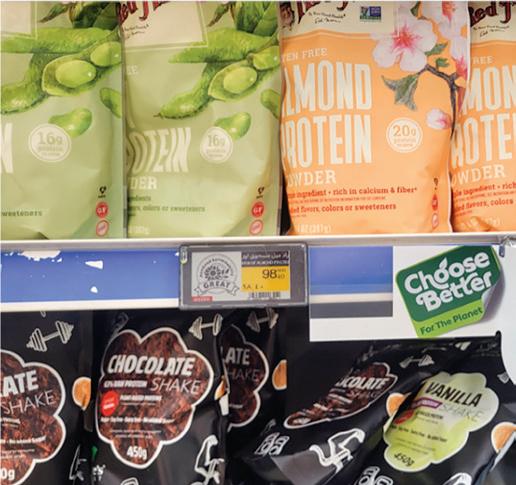

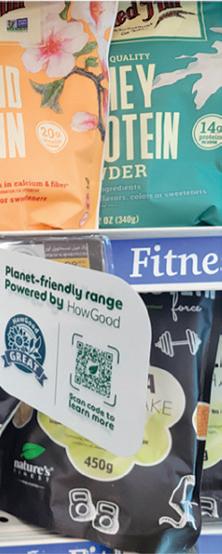
HowGood Impact Ratings can be added to shelves to help differentiate the store experience, enhance loyalty, and prompt the sale of products that introduce better margins and lessen exposure to price sensitivity.
Daniella Vega, global SVP of health and sustainability of Zaandam, Netherlands-based Ahold Delhaize, explained in a Deloitte report that the company is taking several steps to reduce its scope 3 emissions over the next several decades, including focusing on plant-based proteins in its private brands, and including its farmers and growers in its Better For program, which consists of transparent long-term agreements on climate, carbon reduction, sustainability, animal welfare and fair earnings.


“Our scope 3 target is to achieve net zero by 2050, with a 37% reduction achieved by 2030,” Vega noted in the report. “We shortlisted the levers that we would need to pull to support reaching this decarbonization target. We chose to focus on supporting the supply chain to decarbonize, on livestock and regenerative agriculture, and on providing a sustainable diverse assortment through, for example, the shift to more plant-based proteins.”
As the regulatory environment and investor expectations evolve, retailers may find that their ability to measure emissions, including scope 3, could have a direct impact on their financing costs, Rochkin notes. “Leading retailers are making this a core part of their supplier engagement model and are building dedicated data and analytics capabilities,” he says.
Rochkin adds that sustainability programs focusing on waste reduction are another avenue where retailers can generally find a strong return.
“We chose to focus on supporting the supply chain to decarbonize, on livestock and regenerative agriculture, and on providing a sustainable diverse assortment through, for example, the shift to more plant-based proteins.”
—Daniella Vega, Ahold Delhazie
50 progressivegrocer.com FEATURE
Prosur Presents
Crave consumer trust?


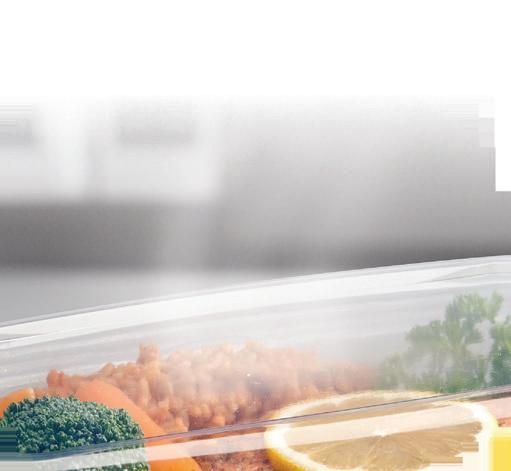
Tamper Evident Polypropylene Packaging for hot food applications

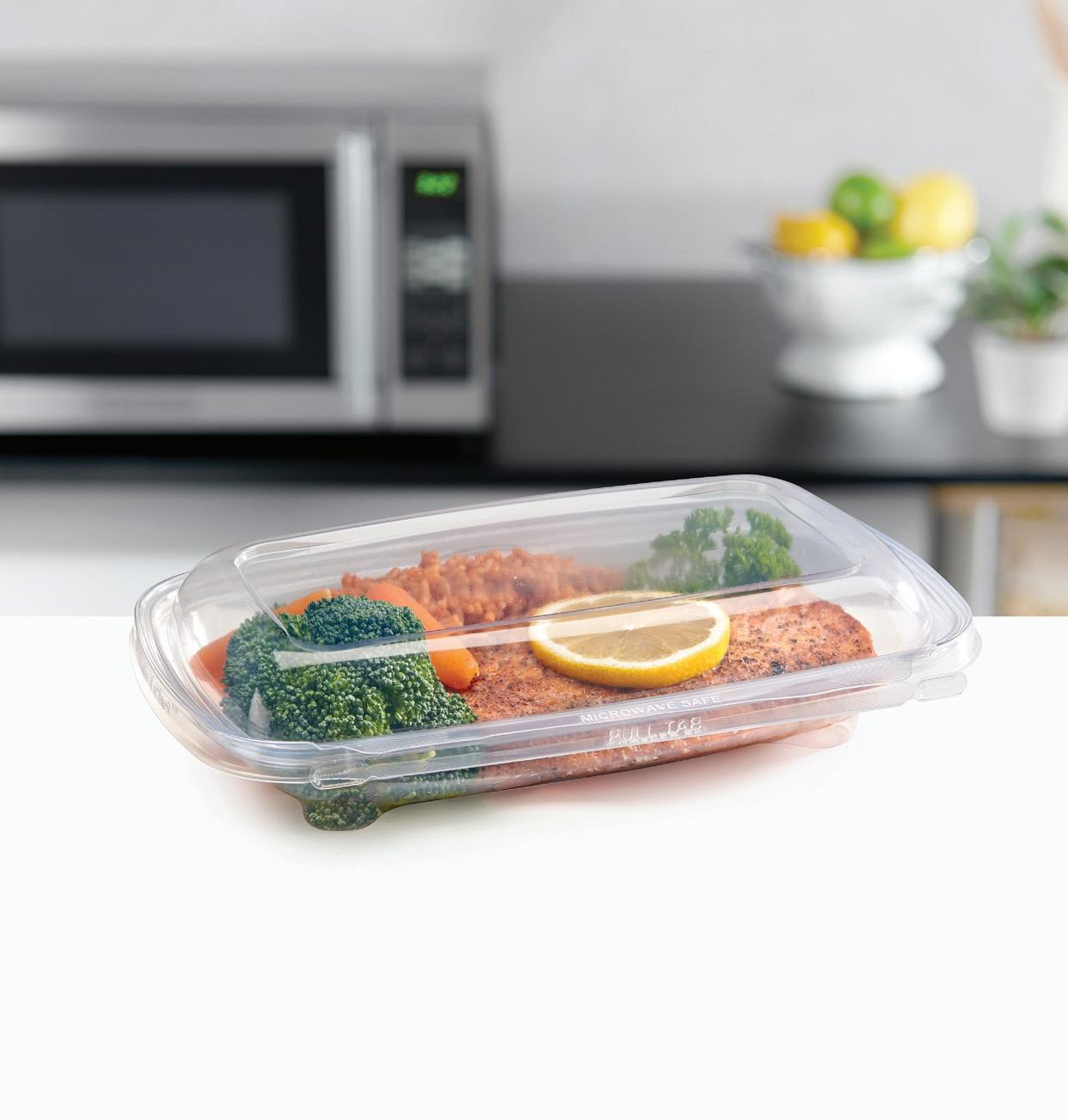

Tamper Protection
Proven patented technology gives consumers confidence that food has remained sealed. Great for delivery!
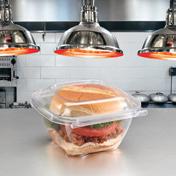
Full Transparency
Exceptional clarity because shoppers like to see the food they buy.

Sustainability
You will be ready as the shift away from black carbon plastics continues.
We strongly recommend that customers test products under their specific conditions to determine fitness for use.
Scan to learn more
Environmental, Social and Corporate Governance
“This can take the form of programs to drive demand for products that otherwise would become waste, such as produce with imperfections, or store capabilities improvements that eliminate over-ordering and overproduction,” he explains. “These programs benefit from both their positive environmental impact and reducing a retailer’s shrink cost.”
For its part, Phoenix-based Sprouts Farmers Market is seeing sustainability initiatives pay off behind the scenes. Lampert notes that the grocer recently closed a $700 million revolving credit line connected with its ability to meet goals related to sustainability initiatives. As such, the company is able to incur lower borrowing costs under the loan facility if it achieves objectives for the sale of socially and environmentally sustainable products and the diversity of its board directors.
Taking a different tack, Pittsburgh-based Giant Eagle recently relaunched its Nature’s Basket private label brand and, in doing so, focused on offering products that are responsibly sourced and offer high-quality ingredients. The grocer teamed up with HowGood to evaluate the environmental and social impact of each item in the Nature’s Basket line and to provide a comprehensive sustainability rating for its customers to consider.
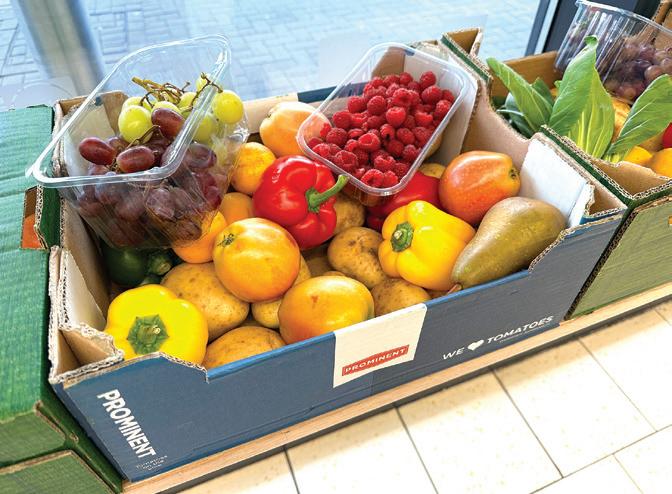
programs that focus on waste reduction are an avenue where retailers can generally find a strong ROI.
Lampert explains that the HowGood Impact Ratings and Impact Attributes like those given to a selection of Nature’s Basket products can be added to shelves as a means to differentiate the store experience, enhance loyalty, and prompt the sale of products that introduce better margins and lessen exposure to price sensitivity, all while decreasing scope 3 emissions.
When it comes to sustainability initiatives that affect heating, ventilation and air-conditioning (HVAC) systems, Patenaude believes that improving energy efficiency is one of the biggest opportunities for long-term ROI. Since energy efficiency is a scope 2 goal focused on lowering indirect greenhouse-gas emissions from all sources of energy consumption, having modern systems in place that are smarter, more automated, and optimized for spe -
“Programs to drive demand for products that otherwise would become waste, such as produce with imperfections, or store capabilities improvements that eliminate overordering and overproduction, benefit from both their positive environmental impact and reducing a retailer’s shrink cost.”
—Corey Rochkin, Oliver Wyman
cific applications and operating conditions can help greatly reduce energy costs.
Going Beyond the Dollar
While financial ROI is obviously incredibly important to a food retailer’s bottom line, sustainability initiatives can also provide ROI in different ways. Rochkin believes that these programs are increasingly important to attract and retain talent, and he’s also seeing brands begin to include a retailer’s sustainability agenda as a criterion when deciding product placement and funding levels.
Patenaude also stresses the fact that sustainability programs can help to garner credibility in the food retail sector, where many consumers and investors are more aware of, and often prefer, companies that pursue more sustainability activities. “Companies with formalized ESG programs that can demonstrate progress along their sustainability journeys are well positioned in the retail marketplace,” he asserts.
Not having a firm grasp on sustainability can have quite the opposite effect, Lampert warns, explaining that brand reputation can be tarnished if and when certain on-shelf products are formulated with ingredients from areas that have been flagged for child labor, forced labor or other socially unacceptable practices.
“If the retailer is unaware or does not consider this within their category buying decisions, then they could introduce this risk, should something come out about the brand or even ingredient,” she cautions.
52 progressivegrocer.com FEATURE
Sustainability

Focus on Fixtures
Emily Crowe
he inherent issue with grocery store fixtures is that they’re just that — perennially “fixed” in one place. Naturns, Italy-based Schweitzer is attempting to change the status quo with its customizable refrigeration counters, which can be easily moved to suit changing store needs, as well as evolving customer preferences.
Schweitzer, which has been creating refrigeration solutions for nearly 100 years, recently rolled out its next generation of movable refrigerated display fixtures. Promising spatial flexibility along with sustainability benefits, the plug-in cases use an onboard waterloop system to cool the integrated unit within the case and keep products at the necessary temperature.
The counters are highly energy-efficient and can hold products ranging from fresh meat and seafood to packaged items and produce, and also offer retailers both a served and self-service option.
The Benefits of Flexibility
By having flexible counters, entire grocery departments become flexible, explains Matthäus Streitberger, Schweitzer’s head of operations for North America. The company’s self-contained solution allows for an easy enlargement or reduction of departments by adding or reducing fixture
Key Takeaways
Schweitzer has recently rolled out its next generation of movable refrigerated display fixtures.
By having flexible counters, entire grocery departments become flexible.
Flexible counters can offer a new and improved shopping experience for customers.
PROGRESSIVE GROCER March 2024 53 EQUIPMENT & DESIGN Fixtures
CAN
FIND OUT HOW FLEXIBILITY AND MOBILITY
CHANGE THE GAME. By
Flexible fixtures from Schweitzer are self-contained
and
can be easily integrated into existing infrastructure.

EXTRUDED SIGN HOLDERS ENDLESS BASKETS AND DIVIDERS FENCING AND DIVIDERS FLIP-SCAN HOOKS POUCH HOOK MERCHANDISING AMT SHELF MERCHANDISING SCAN-LOCK HOOKS AUTO FEED PUSHER SYSTEMS TRION INDUSTRIES, INC. | HOOKS | SHELF MERCHANDISING | LABEL HOLDERS
THE ART OF

MERCHANDISING ® ZIP TRACK ® SHELF MERCHANDISING DISPLAY AND SCAN HOOKS CLEAR ACRYLIC DIVIDER SYSTEMS OVERSIZE PRODUCT MERCHANDISING DUAL LANE MERCHANDISING CLEAR SCAN® LABEL HOLDERS AND STRIPS WWW.TRIONONLINE.COM/ART | 800-444-4665 | ©2022 Trion Industries, Inc. WONDERBAR® TRAY MERCHANDISING WONDERBAR® HOOKS
Fixtures

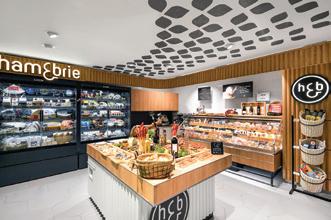

modules, and also enables grocers to change the layout as necessary, or based on seasonal events and assortment changes.
Schweitzer’s flexible fixtures are self-contained and come in a plug-and-play version that simply needs access to power, so they can also be easily integrated into existing infrastructure. In the case of full department renovations, they also reduce potential construction time and disruption of sales and customer service.
“There is no need to wait eight to 10 years and heavily invest in the complete modernization of a store, something that has been very common up to now,” says Streitberger. “The flexibility offers financial as well as energy-efficient sustainability and therefore kills two birds with one stone.”
Enhancing the Customer Experience
According to Streitberger, Schweitzer’s flexible counters can offer a new and improved shopping experience for customers, and can help grocers introduce different modes of selling and employee interaction. Central Food Hall Ladprao, in Bangkok, for example, uses the cases in some areas to create a marketplace-like ambiance where employees stand in front of the counter to assist customers.
Conversely, when there are labor shortages, self-contained count-
“Fixtures can deliver the most important information to consumers through clever communication and contribute to an emotional, warm atmosphere.”
— Matthäus Streitberger, Schweitzer
ers can easily be switched from served to self-service to eliminate the need for additional employee support.
Most important, Streitberger notes, is the ability for these fixtures to transform visual merchandising into an avenue for creative storytelling. “Fixtures can deliver the most important information to consumers through clever communication and contribute to an emotional, warm atmosphere,” he explains.
Fixtures in Action
At Kahala Market by Foodland, in Honolulu, Schweitzer integrated two fresh islands, one with fresh poké and seafood products, and one with charcuterie and cheese. Both islands are plug-in and flexible, and the installation was done by simply connecting the islands’ water and power supplies via artificial columns. The grocer was able to avoid heavy construction work, and the whole remodel was completed in just two-and-a-half weeks.
For German supermarket company Edeka’s new Hieber’s Frischecenter, in the town of Bad Krozingen, Schweitzer was tasked with emphasizing the grocer’s extensive fresh produce offering both in design and graphic communication.
The flexibility and modularity of Schweitzer’s refrigerated counters help to guarantee an unrestricted shopping experience with a range of products, and depending on customer flow, the displays can be quickly and flexibly changed from service to self-service. Additionally, fresh products are presented vertically, as in the form of a cheese tower, to give space and visibility to the large assortment.
56 progressivegrocer.com EQUIPMENT & DESIGN
Schweitzer's refrigerated fixtures allow retailers to change things up with very little effort, while also offering benefits in terms of labor and potential construction overhead.
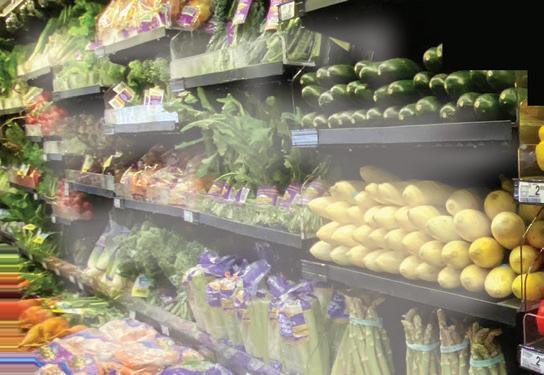






The new face of produce merchandising

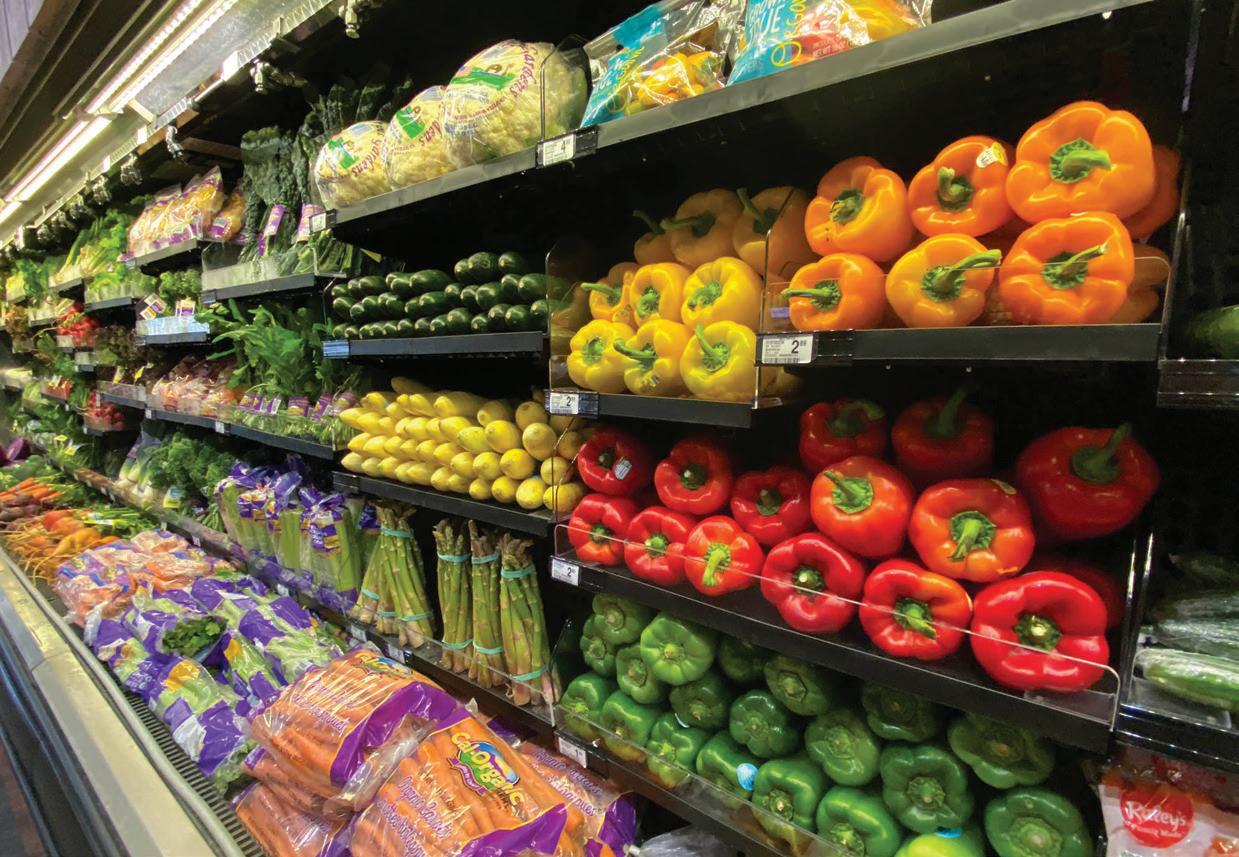

Accessories to face product

Easy access to the well

Cut cleaning time in half
Showcase freshness with an attractive wall of produce
Customers all over the world are raving about how ModoShelf™ is changing the way they merchandise and manage their produce section in coolers.
Using standard ModoShelf components, you can create a system that uses various shelving depths and inventory blocker panels. These shelves act as natural “baffles” to facilitate air-flow from the rear of the case to support the “air curtain” at the front, and don’t disrupt the refrigeration efficiency like other upright racking systems. Inventory blockers have large holes to ensure this proper air circulation is not impeded.
Find out why so many grocers are making the move to ModoShelf™!

Fits in any produce cooler
AHEAD OF WHAT’S NEXT
By Bridget Goldschmidt
By Design
FOODTOWN STORE OWNER SHADY WIDDI CREATES A UNIQUE OASIS IN A BROOKLYN NEIGHBORHOOD.
t fi rst glance, the Bushwick section of Brooklyn, N.Y., is a bustling concrete landscape featuring rows of small businesses, with nothing remarkable to catch the eye, but walk a few blocks from the elevated subway station, and you’ll fi nd a quieter community boasting what may be the borough’s most inventive grocery store.
The approximately 15,000-squarefoot Foodtown on the corner of Noll Street has been a true labor of love for store owner Shady Widdi, whose family operates two other Brooklyn supermarkets under the banner serviced by Iselin, N.J.-based Allegiance Retail Services. For one thing, the Bushwick store boasts various unique custom design features that set it apart from most area grocers. These include elliptical produce fi xtures, whose shape is echoed by the nearby hot-/cold-food bar; roomy refrigerated end caps; an installation of constantly rotating gears to suggest a place that’s “always on the move”; graffiti-style artwork in the meat department; LED boxes in the frozen food section; and dramatic floating ceilings with an undulating motif.
Destined to Stand Out
Asked how this store’s distinctive look came about, Widdi notes that while he waited to take possession of the Noll Street location, for which he has a 50-year lease, he worked on his other stores, but “I knew that this design was going to be the one that was going to blow everybody out [of] the box. Everybody builds supermarkets – everybody – but what differentiates this person from that person is what they can do better, what they’re bringing to the table. … What can you bring to the table that nobody else has? How can you stand out?”
For Widdi, this meant gaining inspiration from retail stores that he encountered during trips abroad. “Even when we would go on vacation, my wife would be like, ‘Why are you taking pictures? You’re always into business,’” he recounts, adding that he would reply, “‘This is just an idea for the future. Maybe I’ll do it.’ Finally, all those pictures that I took over the years paid off.” He was particularly captivated by businesses he visited in Europe, observing, “I think they’re way ahead of us in design.”
Realizing the Dream
Getting his own vision just right proved daunting, however. During the years it took to get the store ready, “I was calling my designer every six months [with] changes,” admits Widdi. “I drove them crazy.”
He goes on to explain: “When you build out the space, you plug in whatever you think you can plug in, and then tweak things around. So you keep plugging and playing until you get [it] the way you want it. And especially because this store was so big [by New York City standards], it was something that I’ve always wanted to put everything that was in my dream to put in one store. And as I was going over time, I was adding more depart-


unusual design elements as custom-made elliptical produce fixtures and dramatic floating ceilings.
ments and taking away departments. I had a pizzeria, but then I discussed [it] with so many supermarket owners, and they told me: ‘Shady, I don’t think you should do it. A pizzeria is not doing good for any of us.’ It was something that came off my plans.’”
Despite the store’s upscale look, Widdi wanted to make sure that the many lower-income customers in the area weren’t scared away by high prices. “I probably have more deals than my surrounding supermarket competitors,” he asserts.


As for future plans regarding the store, Widdi still intends to build an outside café so customers can relax outside with a cup of coffee when the weather improves, as well as to install an ornamental fish tank – although not with the sharks that he originally wanted. “As I go, I’m still adding more and more,” he says. “I am not going to get this store to the perfection that I want until maybe one year from now. Come back in a year, and you’ll see.”
Bridget Goldschmidt Managing Editor bgoldschmidt@ensembleiq.com
58 progressivegrocer.com



ACTIONABLE INSIGHTS & CONNECTIONS POWERING BUSINESS GROWTH
EnsembleIQ is the premier resource of actionable insights and connections powering business growth throughout the path to purchase. We help retail, technology, consumer goods, healthcare and hospitality professionals make informed decisions and gain a competitive advantage.
EnsembleIQ delivers the most trusted business intelligence from leading industry experts, creative marketing solutions and impactful event experiences that connect best-in-class suppliers and service providers with our vibrant business-building communities.



















ENSEMBLEIQ.COM



























 Gina Acosta Editor-In-Chief gacosta@ensembleiq.com
Gina Acosta Editor-In-Chief gacosta@ensembleiq.com




















































































































































































 Bacon is a star ingredient in many packaged goods, too, like Oscar Mayer's new line of Scramblers.
Bacon is a star ingredient in many packaged goods, too, like Oscar Mayer's new line of Scramblers.























































































































































































































































































